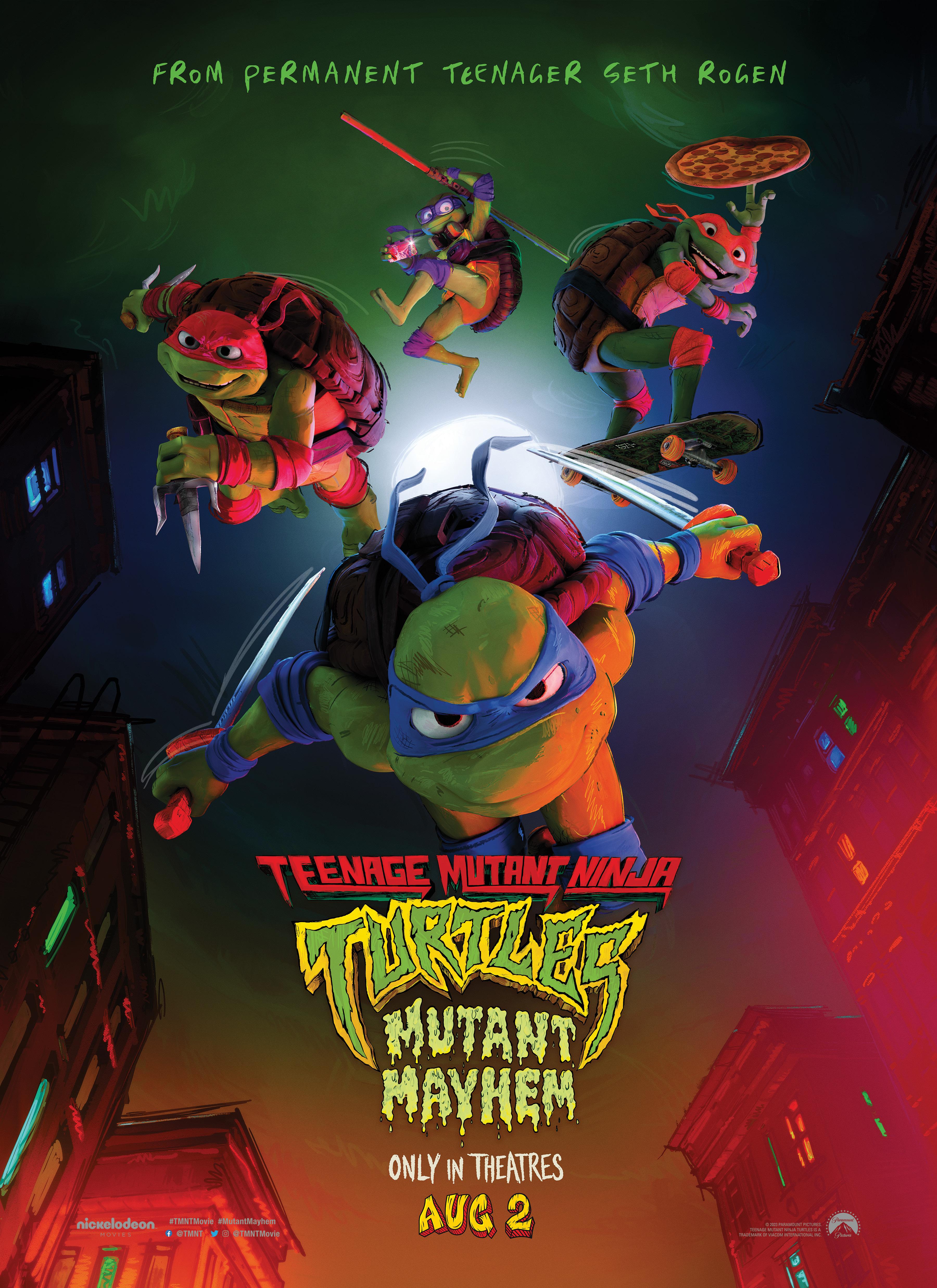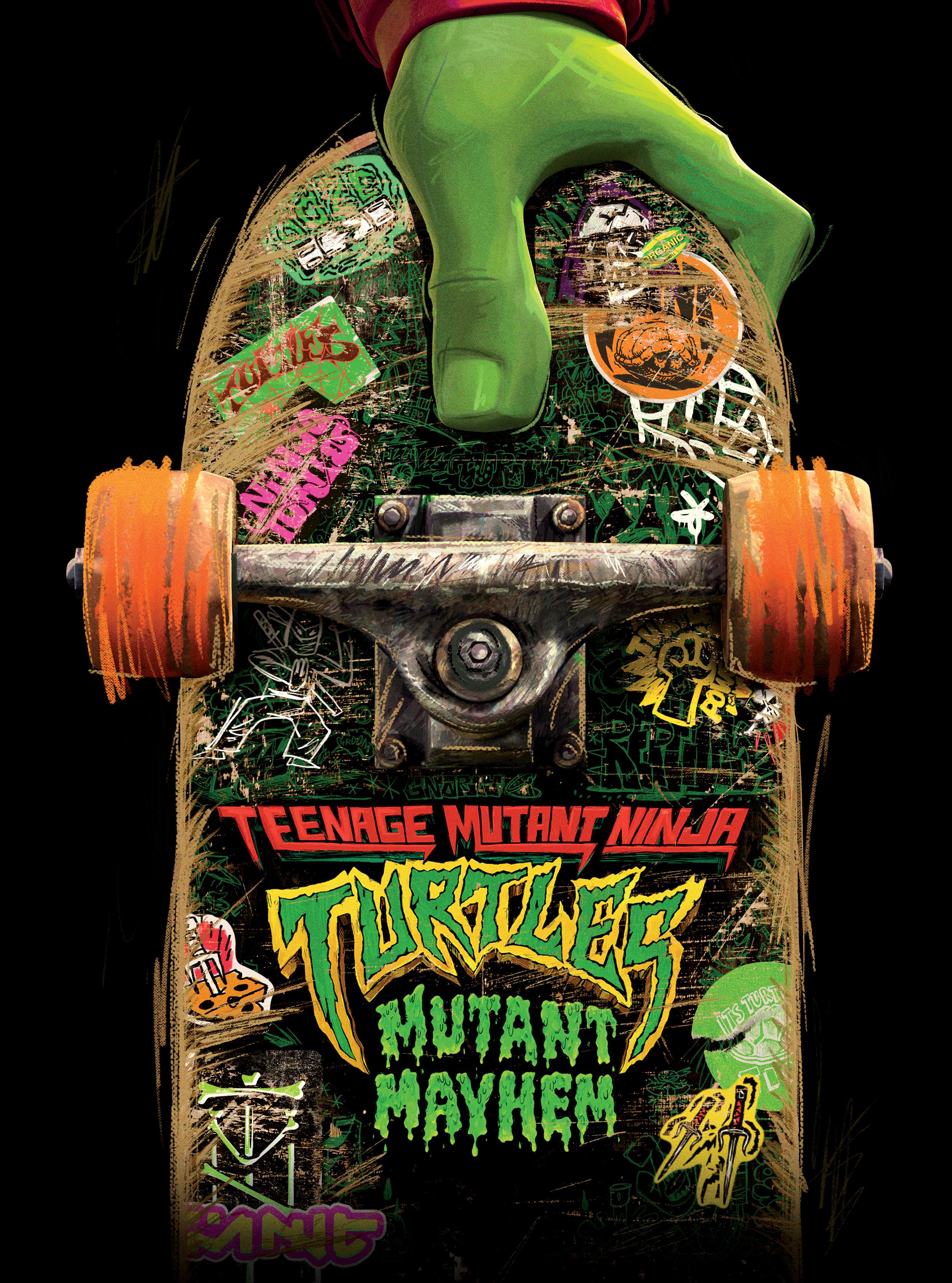OFFICIAL
SPECIAL EDITION
EXCLUSIVE CAST INTERVIEWS





OFFICIAL
EXCLUSIVE CAST INTERVIEWS




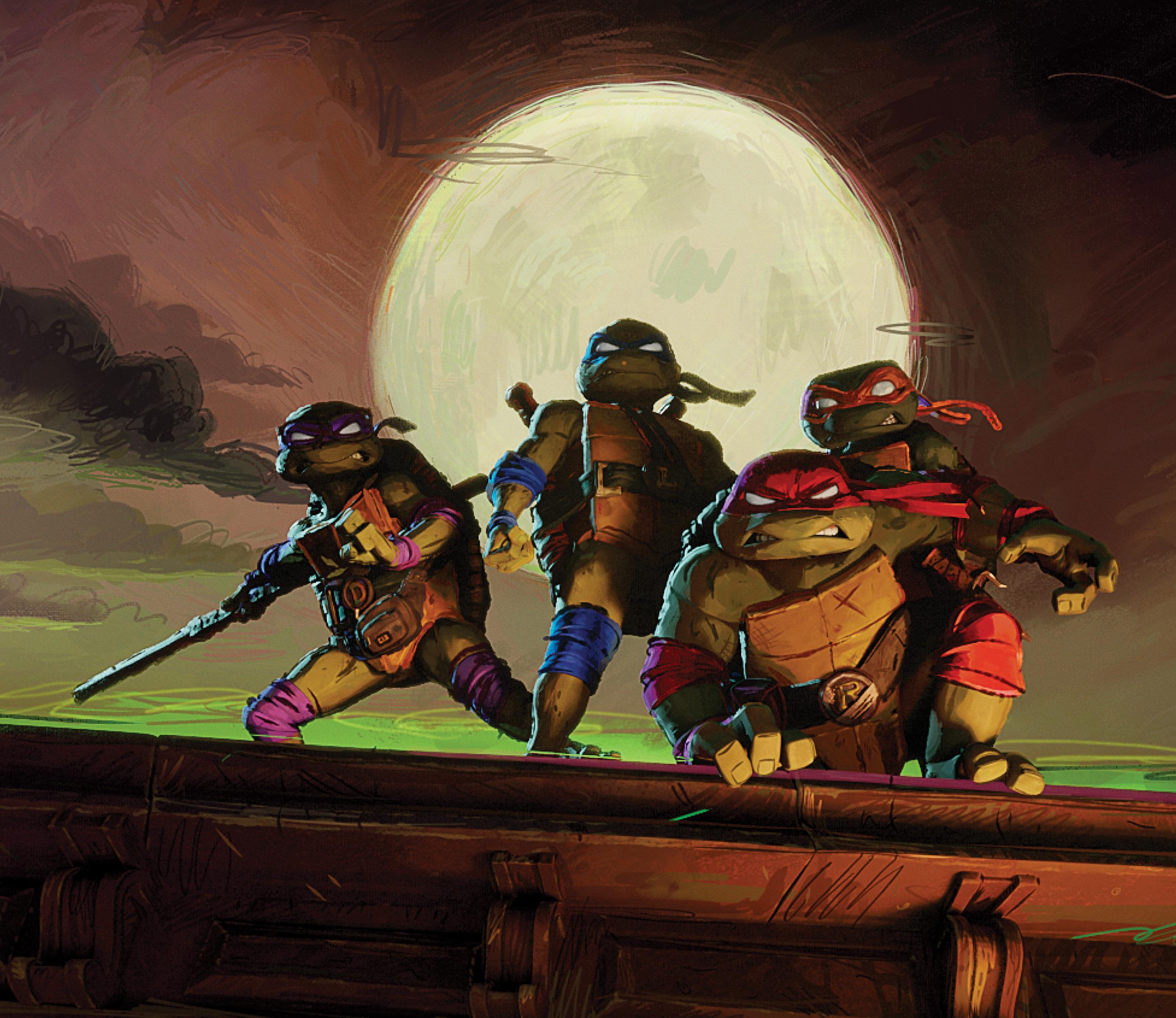
How do you keep a new Turtles movie feeling fresh and dynamic? Director and co-writer Jeff Rowe, co-writer and producer Seth Rogen and producer James Weaver tell us about focusing on teen energy. PG. 6
Get to know the actors who bring the characters to life! We catch up with the core four teen turtles, Donatello, Leonardo, Michelangelo and Raphael as well as journalist and turtle pal April O'Neil, and mutant baddies Superfly and Bebop. PG. 12
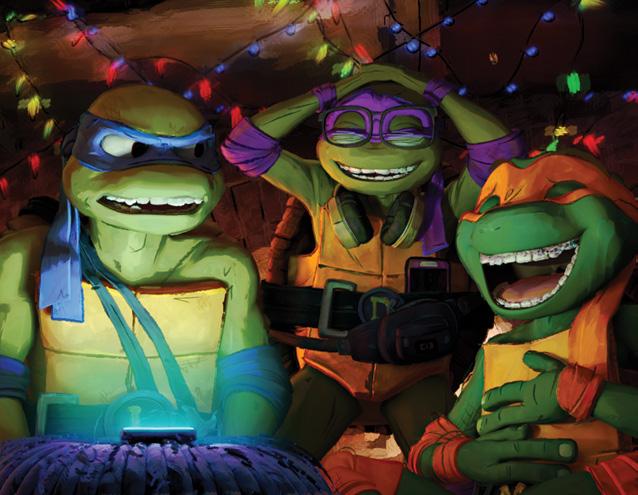
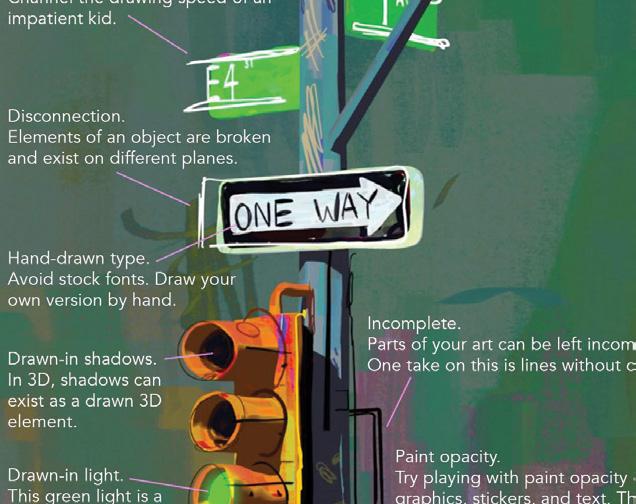
In our in-depth, flagship interview we sit down with legendary comic book artist and writer Kevin Eastman, who co-created the Teenage Mutant Ninja Turtles. Eastman takes us back to the origins of what's become a massive global phenomenon. PG. 28
Head of cinematography Kent Seki, production designer Yashar Kassai and lead character designer Woodrow White bring us into the wild world of Mutant Mayhem and showcase concept art. Plus, meet the rest of the mutant misfits that populate the movie. PG. 22
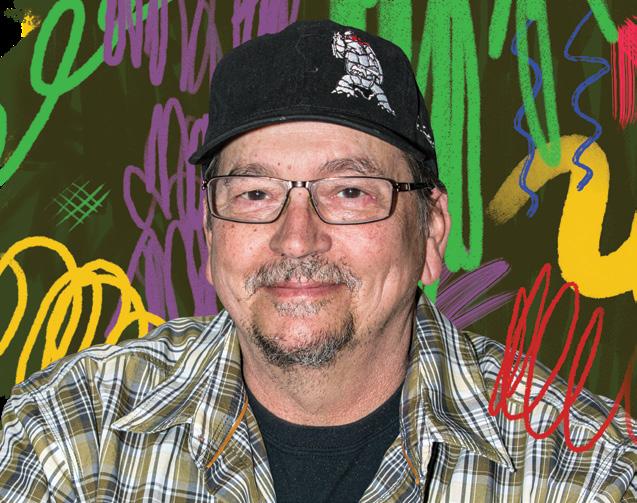
There’s a saying, often attributed to Brian Eno, but that may have been the legendary musician quoting the equally legendary Lou Reed, about how the first Velvet Underground album didn’t sell very many copies, but “everyone who bought one started a band.” You might be able to say something similar about 1984’s Teenage Mutant Ninja Turtles #1 by Kevin Eastman and Peter Laird—a self-published independent comic that the pair only printed 3,000 copies of. But for a time, it felt like anyone who read one of those early copies, especially as the legend grew about how such humble beginnings spawned one of the most enduring pop-culture franchises of a generation, started making comics of their own.
That was certainly true in my case. I was way too young to have gotten in on the ground floor of the original Teenage Mutant Ninja Turtles comics. Early printings of that legendary first issue were already fetching absurdly high price tags by the time I became aware of them. No,
like most Gen X-ers, my first exposure to TMNT came via the animated series and the first wave of toys, which sparked an immediate, profound obsession in my preadolescent brain. When my best buddy and I realized that the cartoon and action figures sprang from a little black-and-white comic that was self-published by a pair of friends, we spent the rest of the school year (much to the annoyance of our teachers) and the entire summer writing and drawing our own comics. And no, we didn’t think fame, fortune, or TV and merchandise deals would come our way. We did it because the sheer joy of creation and a sense of wild, unfiltered imagination was so clearly baked into the TMNT concept that it was infectious.
The Turtles were, for lack of a better word, my friends As an awkward kid who didn’t always do well socially, I envied their brotherly camaraderie, and I’ve tried to bring the way they always have each other’s backs (or um… shells) to the good friendships I’ve been fortunate enough to forge. I studied their effortless wiseassery as surely as
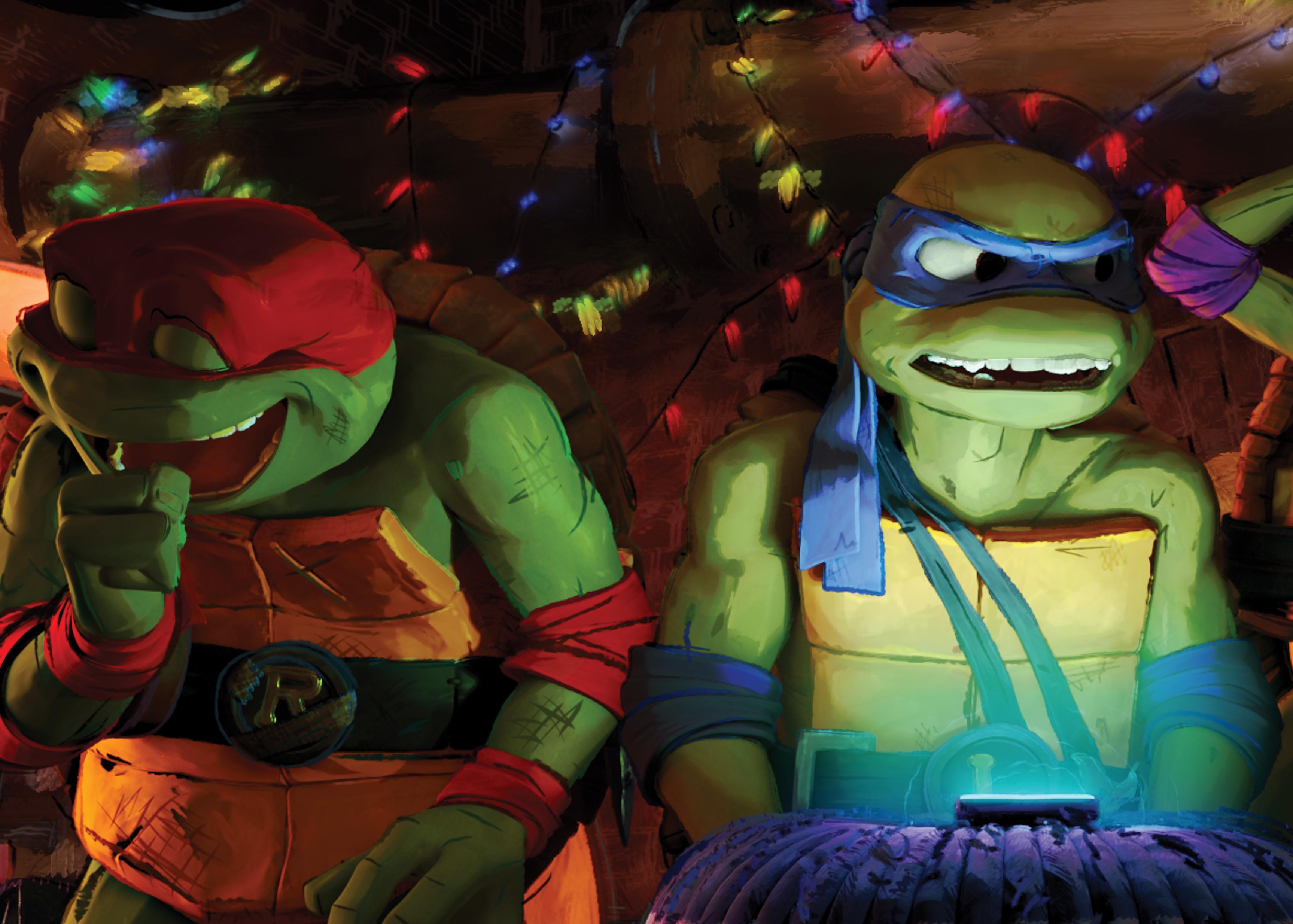
I wished for their martial arts prowess. It seems that at various points in my life, I find new reasons to rediscover and love some fresh iteration of their adventures, whether through new comics, video games, TV shows, and, of course, movies.
TMNT is a pop culture institution now. And like other prominent franchises, every generation deserves their own interpretation of the myth. Fortunately, Teenage Mutant Ninja Turtles: Mutant Mayhem is imbued with that same imagination, humor, and sense that anything can happen that hooked me and generations of fans in the first place. It’s the perfect entry point for new fans, just as it is welcoming for those who have been prowling the sewers with the Turtle boys for years. It’s a group high-five from your four best friends. It’s a welcoming hug to anyone who has ever felt a little different. It’s an exciting martial arts action romp through (and below) the streets of NYC. In other words, it’s a great Teenage Mutant Ninja Turtles story. The kind that never goes out of style.
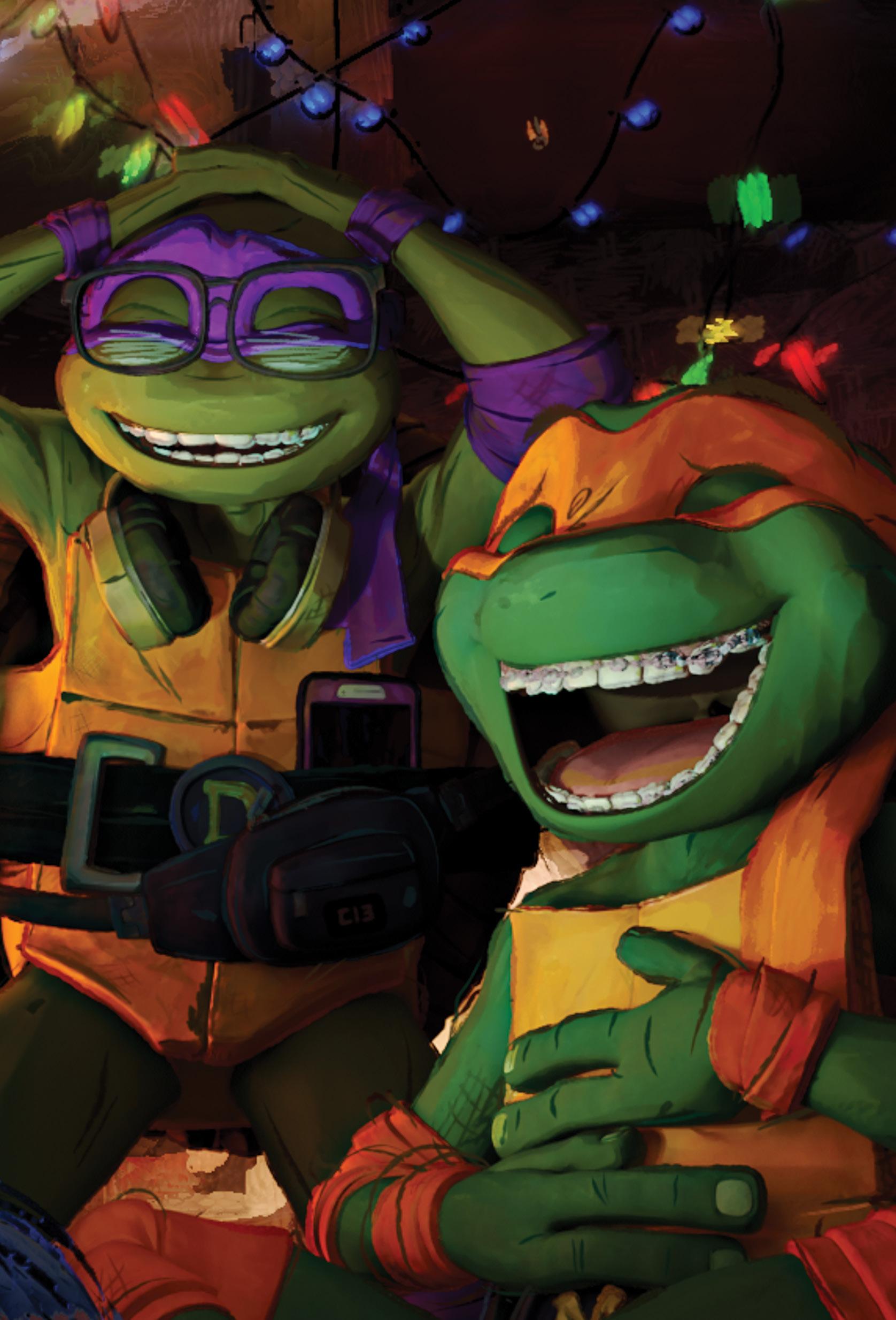
Mike Cecchini, Editor-in-Chief
Mike Cecchini EDITOR-IN-CHIEF
Rosie Fletcher PRINT EDITOR
Chris Longo DIRECTOR OF EDITORIAL & PARTNERSHIPS
ART
Lucy Quintanilla CREATIVE DIRECTOR
Jessica Koynock ART DIRECTOR
Steve Newman DESIGNER
PRODUCTION
Kyle Christine Darnell PRODUCTION MANAGER
COPY

Richard Jordan SUB EDITOR | Sarah Litt COPY EDITOR
Nick Harley ASSISTANT PRINT EDITOR
ADVERTISING
Matthew Sullivan-Pond PUBLISHER
Colby Olson ADVERTISING ACCOUNT MANAGER
Vanessa Chouest ADVERTISING ACCOUNT EXECUTIVE
Mike Cecchini EDITOR-IN-CHIEF
John Saavedra MANAGING EDITOR
Rosie Fletcher UK EDITOR
EDITORIAL
Alec Bojalad TV EDITOR | Matthew Byrd GAMES EDITOR
David Crow SENIOR FILM EDITOR
Kirsten Howard NEWS AND FEATURES EDITOR
Louisa Mellor UK TV EDITOR
ART
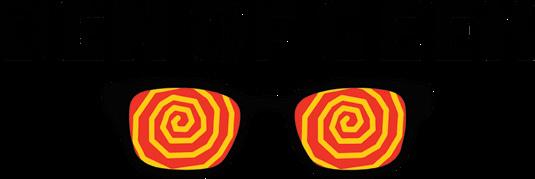
Lucy Quintanilla CREATIVE DIRECTOR
Jessica Koynock ART DIRECTOR
Chloe Lewis JUNIOR DESIGNER
AUDIENCE DEV & SOCIAL MEDIA
Elizabeth Donoghue
HEAD OF AUDIENCE DEVELOPMENT
Maznah Shehzad AUDIENCE DEVELOPMENT STRATEGIST
Lee Parham SOCIAL MEDIA COORDINATOR
PHOTO & VIDEO PRODUCTION
Nick Morgulis SENIOR VIDEO PRODUCER
Andrew Halley HEAD OF VIDEO PRODUCTION
DEN OF GEEK IS A TRADEMARK OWNED BY DEN OF GEEK WORLD LIMITED, A COMPANY INCORPORATED AND REGISTERED IN THE UNITED KINGDOM WHOSE REGISTERED OFFICE IS AT THE BROADGATE TOWER, 20 PRIMROSE STREET, LONDON EC2A 2RS. DEN OF GEEK US INCORPORATION DETAILS: DOGTECH LLC, 601 HERITAGE DRIVE, SUITE 484, JUPITER, FL 33458, PHONE: +1 561-656-2377,
ACTUAL TEENAGERS AND A FRESH, WILD ART STYLE MARK A NEW ERA FOR THE CLASSIC FRANCHISE IN TEENAGE MUTANT NINJA TURTLES: MUTANT MAYHEM.
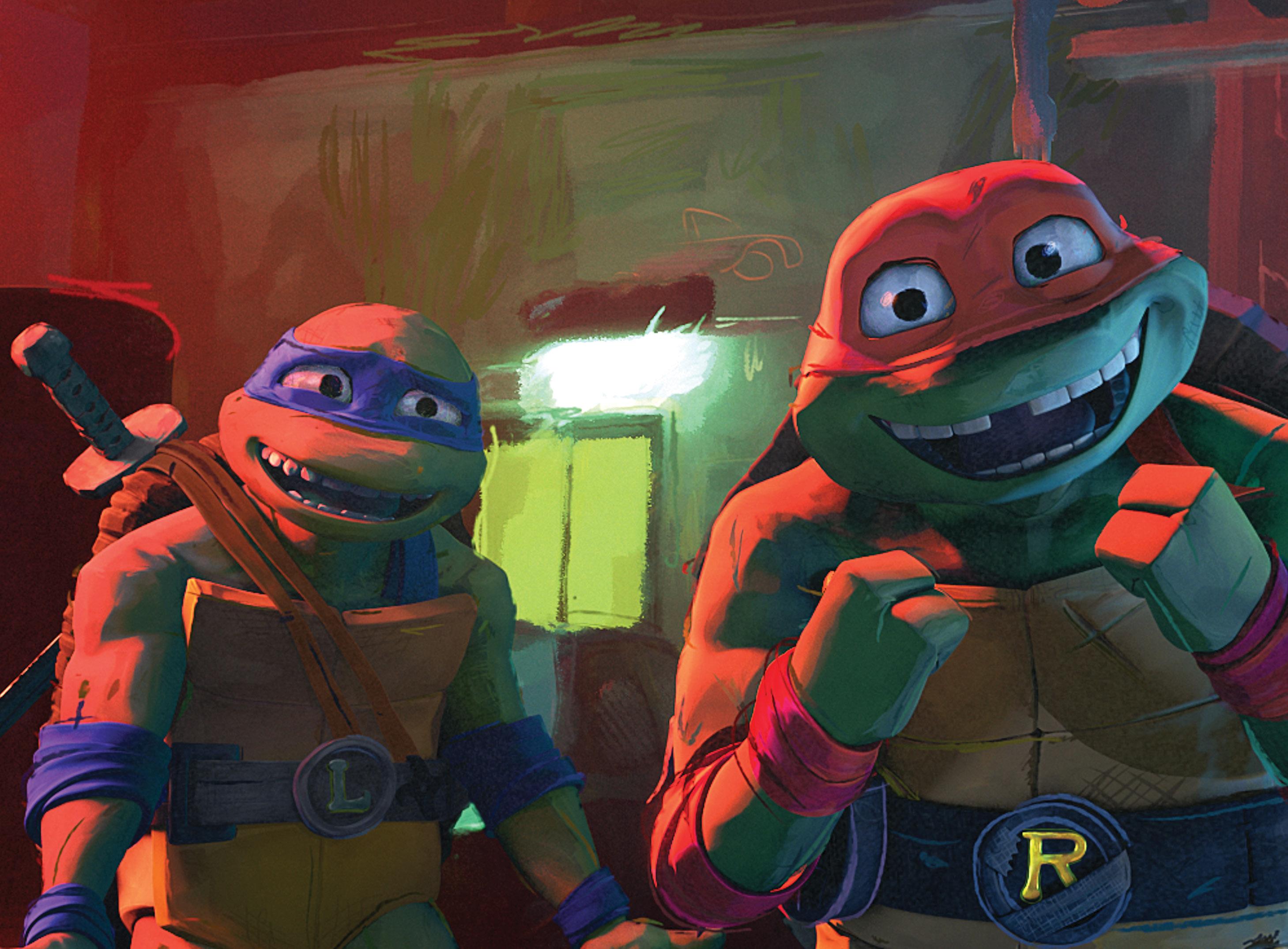
Almost everyone has a memory of the Teenage Mutant Ninja Turtles. Their cultural ubiquity has been maintained for almost 40 years on toy shelves, game consoles, and Saturday morning cartoons, but there’s something about reptilian ninjutsu masters who binge
 BY ERIC FRANCISCO
BY ERIC FRANCISCO
on pizza slices in the New York City sewers that conjures deeply personal recollections of halcyon youth.
No matter when you met Leonardo, Raphael, Michelangelo, and Donatello, you were a fan for life. This is true for the filmmakers of Teenage Mutant Ninja Turtles: Mutant Mayhem. In interviews with Den of
Geek, director and co-writer Jeff Rowe, co-writer and producer Seth Rogen, and producer James Weaver all regale us with tales of growing up with TMNT fever, even dragging their parents on wild toy store hunts to complete their collections.
“It was the first thing that I ever loved in life,” Rowe tells us about
his fandom.

The animation director, whose work includes Gravity Falls and the Netflix movie The Mitchells vs. the Machines, remembers one Saturday during the release of the 1991 film
Teenage Mutant Ninja Turtles II: The Secret of the Ooze when he embarked on an epic quest for villain toys Tokka and Rahzar with his dad. “We just could not find them,” Rowe recalls. Finally, at a store, his father peeked inside a box that wasn’t yet stocked, and it was like unearthing the Holy Grail. “We’re holding them up and cheering, ‘We found them!’ That’s just
like, one of the best days of my life.”
Seth Rogen, an Emmy-nominated comedy writer and star of R-rated juggernauts like Pineapple Express and Superbad, also grew up on the cartoon series like anyone born in the ’80s, and had his mind blown by the live-action movies. He studied kyokushin karate for 10 years because of the Turtles’ influence. “My dad bought me a pair of nunchucks,” Rogen remembers, laughing about it in his signature way. “I could not have been more their target audience.”
Like Rowe, Rogen obsessed over Ninja Turtles toys. “They opened up
my imagination in a lot of ways,” he says. “The toys, honestly, are something we referenced a lot in the design of this movie—how detailed and fun and weird they were.”
However much the TMNT occupy childhoods, the new movie exists to encapsulate all the awkwardness and messiness of the next stage in everyone’s lives: being a teenager.
Rowe and Rogen, along with screenwriters Evan Goldberg, Dan Hernandez, Benji Samit, and some 120 artists from studios Mikros Animation and Cinesite, synthesize
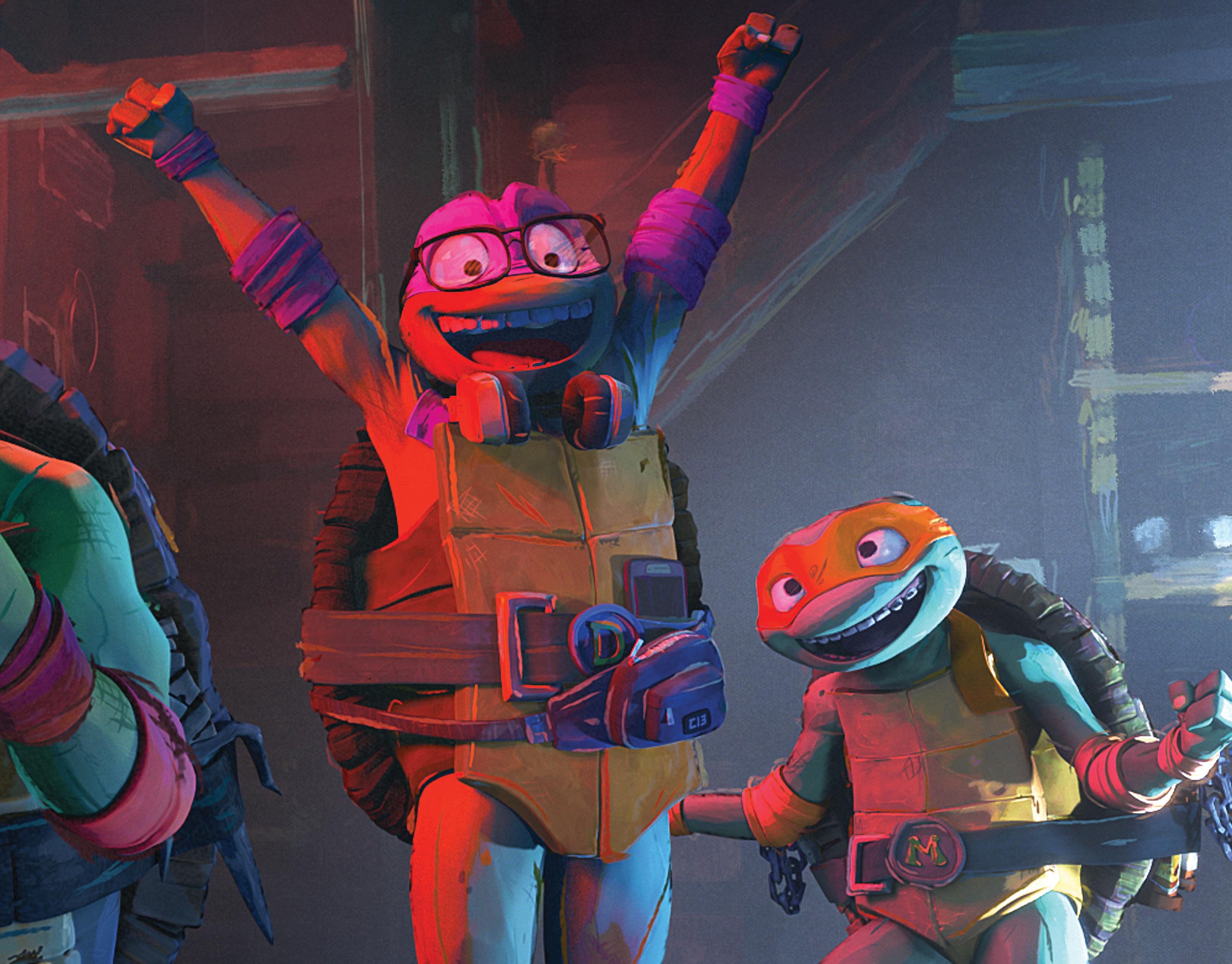
past and present to chart a new future for the franchise. Teenage Mutant Ninja Turtles: Mutant Mayhem reimagines the iconic heroes, who originate from creators Kevin Eastman and Peter Laird. The movie explores the origin of the team and even pinpoints the source of the ooze that gave them feet and fingers to spin sai blades. The Turtles also venture outside and meet people for the first time, like aspiring journalist April O’Neil.
The film brings to the table new and radical ideas for the franchise. In addition to a jagged, street-inspired art style that bursts over lines with restless energy, the Turtles themselves are—get this—actually teenagers, with a cast of real teenage voice actors.
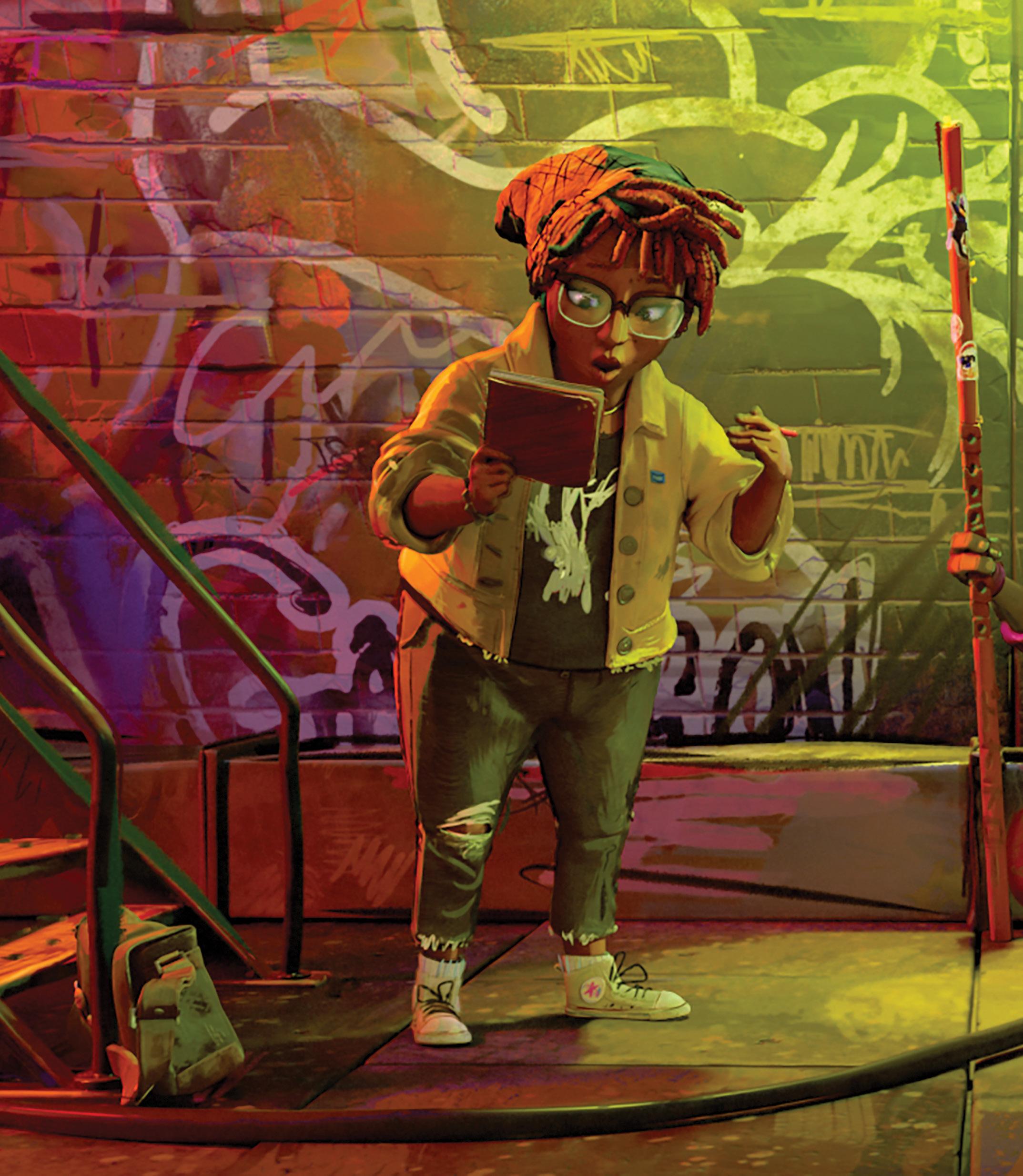
“When we looked at the opportunity to work on Turtles, [we found] that’s the aspect that has been underplayed the most, being a teenager,” says James Weaver. “That freshness about what it is to be a teenager is something that made us excited.”
Rogen adds,“We wanted to make a coming-of-age Ninja Turtles movie that focused on the teenage elements. That, to me, was always kind of the last word in the Teenage Mutant Ninja Turtles. When you’re young, you don’t get that they don’t act like teenagers. To make a movie that served that purpose was really appealing.”
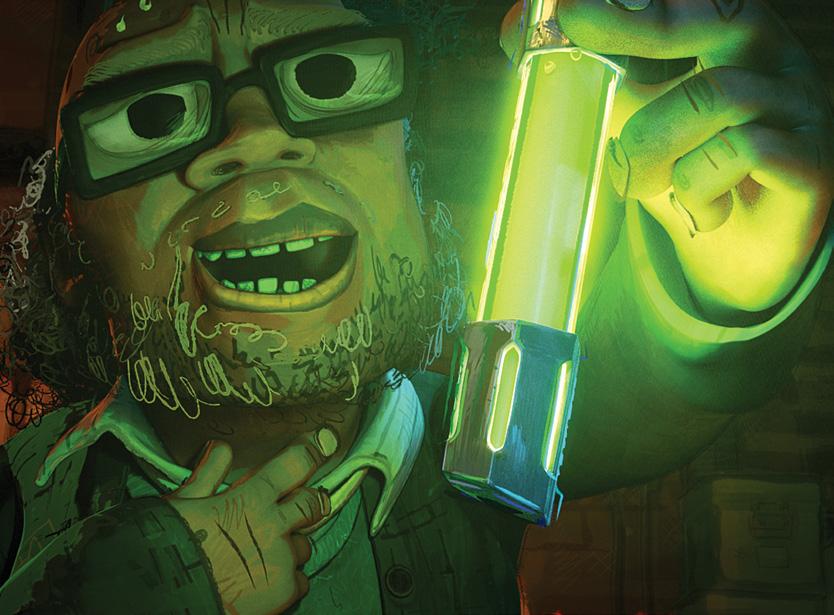
Mutant Mayhem siphons its DNA from Rogen and creative partner Goldberg’s shared experience in teen comedies like Superbad, which Rogen began writing at 13. The two even met as teens; their production company Point Grey is named in honor of their Vancouver high school.
“What’s funny for me and Evan, [writing] was born out of not seeing a lot of movies that we felt represented our high-school experience,” Rogen says. “That was the motivation for Superbad. Then I started Freaks and Geeks. It was a weird convergence, speaking to a lot of themes I thought
were unexplored in the teen genre.”
Now after making influential comedy hits and boundarypushing adaptations of comic books like Preacher, Invincible, and The Boys, Rogen and Goldberg are all-in on Ninja Turtles. Given their background, Rogen felt uniquely qualified to give the Turtles their overdue teen movie. “It’s a genre that was formative to me, creatively,” he says. “This idea of making a Ninja Turtles movie that was focusing on the fact they’re teenagers who want to be accepted and have normal lives; it played so organically into many teenage themes.”
Director Rowe cites influences in Freaks and Geeks, Lady Bird, The Edge of Seventeen, and Pen15 (minor spoilers but a titan of the genre, Ferris Bueller’s Day Off, also gets a nod in the movie). “Being a teenager is one of the most difficult times in a human’s life,” says
Rowe. “Your body changes, all these differences in your chemistry that lead you to have insane feelings. You’re passionate; you’re afraid, angsty, and nervous. You feel the most alone as a teenager.” He adds the best teen movies “engage with the preposterous drama and seriousness” of those years.
Acceptance is a keyword for Mutant Mayhem. Drawing parallels between the Turtles’ isolation from the world and any teenager’s wish to fit in, the movie follows Turtles raised under the overprotective eye of their father, Master Splinter (Jackie Chan), who fears the worst in humanity after being shunned by them. The Turtles live in sewers that no sane person willingly
visits, yet they yearn for that universal desire to live a normal life.
“That was a very early part of the pitch from Seth and Evan,” Rowe says. “It was something they thought was funny. Splinter’s a six-foot tall rat. If a humanoid rat went out in the world, people would try to kill it with fire. That’s something I’ve never seen Ninja Turtles do before. It acknowledges these fantastical things in a way that grounds them in the real world.”
Funny as it is to picture chasing giant rats, the filmmakers found a deeper emotional story. “That’s a great reason for Splinter to keep the family in the shadows,” says Rowe. “He’s a flawed dad who over-indexes on safety, and the Turtles are suffering because of that. It gives the Turtles something to long for because they’ve been denied it their entire lives.”
Pretty much everyone feels like a mutant between ages 13 and 19. “It’s a universal feeling of angst and anguish,” Rogen says. “From my experience, all
teenagers feel a desire to be normal. That was the great marriage of plot and story. If you were a teenage mutant who’s relegated to the sewer but fully ingesting pop culture, you would want nothing more than a normal life.”
In a strange way, one might see Mutant Mayhem as a complementary double feature with Superbad “Superbad is about the same thing,” Rogen points out. “It’s a timeless feeling. ‘Why are we weird? Why aren’t we doing things that everyone else seems to be doing? Why aren’t we invited?’ All those ideas are so relatable and worked with the weird plot Mutant Mayhem has.”
At first blush, Mutant Mayhem is unlike anything seen in TMNT
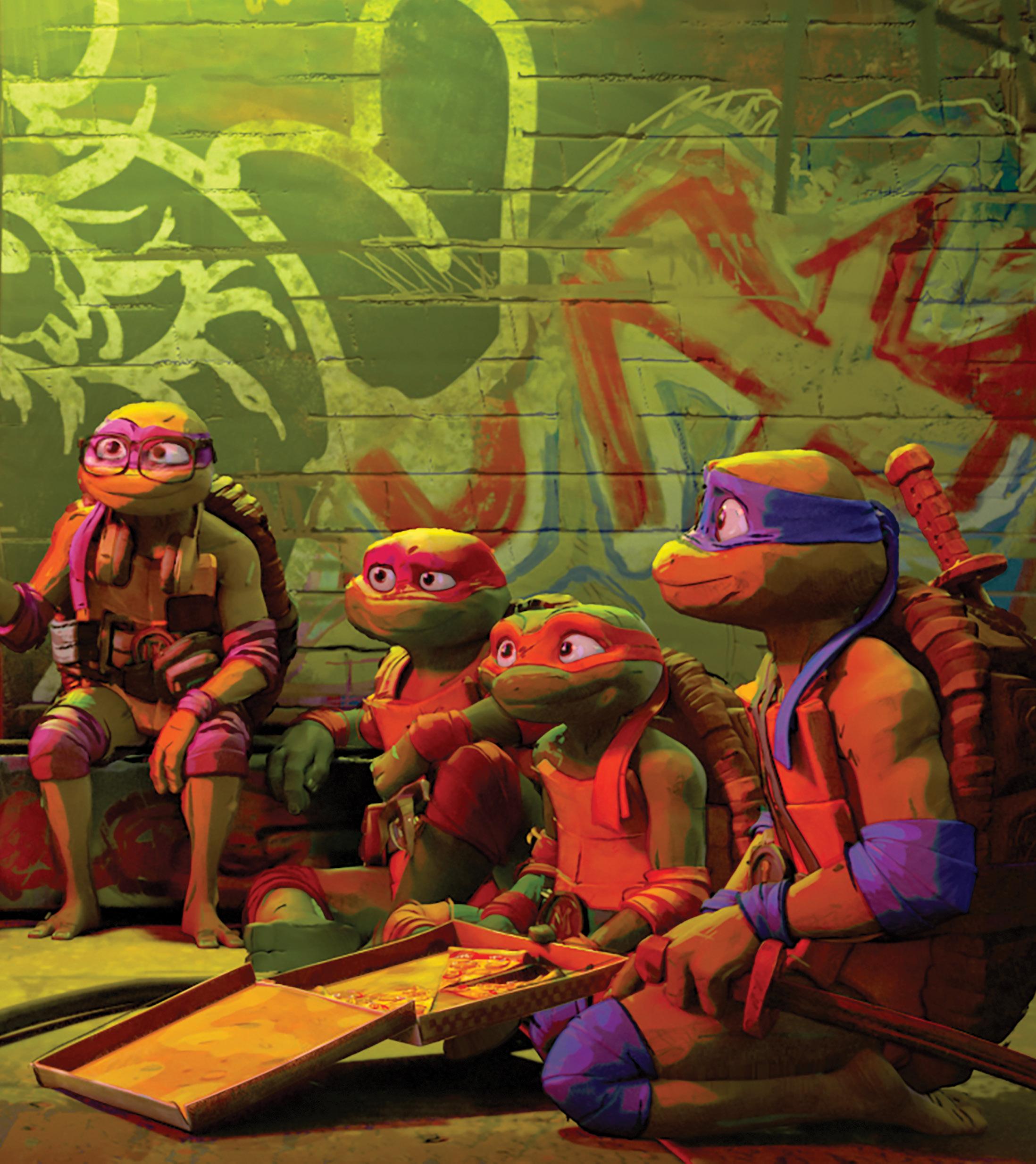
history. The New York boroughs it takes place in aren’t characterized by clean lines and ultra-realistic fidelity. Instead, the movie wholly embraces the franchise’s roots in independent comics. It also references urban photography and the chaotic doodles that pack a high schooler’s notebook.
Audiences may catch vibes reminiscent of another groundbreaking reinterpretation of a comic book icon: Spider-Man, and the celebrated Spider-Verse movies. But Rowe says that Mutant Mayhem is striving for something different. “We get a lot of that,” the director admits, who sees the Spider-Verse films as slick, clean, and symmetrical. “We’re the opposite, but I do think a lot of films being made now owe a little bit of debt.”
Mutant Mayhem’s north star lay in something different than what the Spider-Verse franchise aims for. Going back to the teen spirit of the movie, the filmmakers’ goal was to mix what Rogen calls “the scribbly doodles you make in the back of your binder during class” with New York’s own storied history as the backdrop for trendy, high-contrast street photography.
“We looked at the drawings you make when you’re a teenager,” says Rowe. “Everything you learn in animation school is to simplify and unify shapes, but [as a teenager] you don’t know any of that. You’re drawing nostrils and acne. You render with care and focus, which is betrayed by the fact you have no formal training. It’s that interplay between passion and not knowing what you’re doing we tried to capture, because it felt so decidedly ‘teenage.’”
Rowe, whose film The Mitchells vs. The Machines had a similarly unbridled lo-fi look that bucked mainstream animation standards, says movies like Mutant Mayhem are indicative of a new emerging style. “It’s sketchy; it’s lumpy; it’s deconstructed. It’s a humanist style that emphasizes imperfection, while CG animation spent 30 years trying to make things photorealistic. This is steering the ship 180 degrees towards something impressionistic and not conventional.” He adds: “It’s rebellious, it’s relevant. It’s like grunge music.”
Let us not forget those beloved Ninja Turtles toys the filmmakers
prized as kids. Of all the iconic franchises that pack a toy box, be it Transformers or Power Rangers, TMNT is marinated in gooeyness. “In the early ’90s, gross was an aesthetic,” says Rowe. The Ninja Turtles especially were “like molded plastic fever dreams.”
“They were so inventive… Like Michelangelo in a scuba suit had a starfish stuck to his butt. It had a huge influence on my taste, which is an appreciation and love for things that are weird and not slick and clean. It inspired me to tell stories and have a sense of humor.”
This appreciation dripped into the team’s approach to Mutant Mayhem
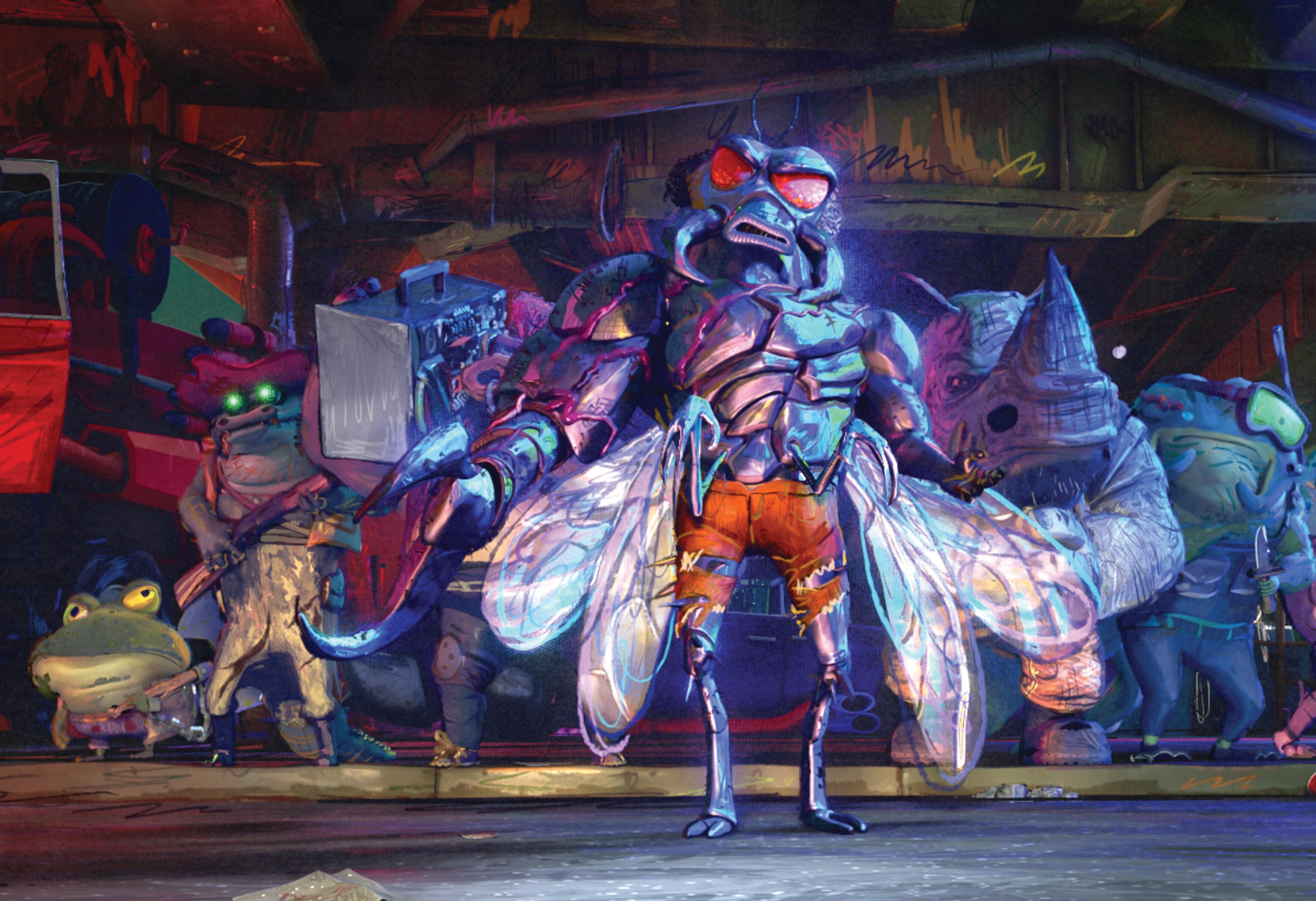
Seth Rogen says the filmmakers strove to keep what was drafted in the concept art. “I’ve been through this process so many times where you see the concept art and by the time you’re making the movie, it has lost all of its energy. That did not happen here,” he reveals. “It was asymmetrical and imperfect. I remember the first time seeing it dimensionalized, and it blew my mind.”
The story and style of Mutant Mayhem boast teenage vigor, but to hear adults voicing the core team would betray all that the filmmakers envisioned. So it was critical that, for the first time ever, the Ninja Turtles are played by actual teenagers. “Part of the spirit we were trying to capture was to make the movie fun, like kids playing with toys,” says Rogen, revealing that even his adult co-stars had fun playing off each other IRL. “That was something we talked about. How do we make it feel fun and silly? This reckless weirdness that almost every kid playing with their toys has?”
Actors Nicolas Cantu (The Walking Dead: World Beyond), Brady Noon (Good Boys), Shamon Brown Jr. (The Chi), and Micah Abbey (Grey’s Anatomy) voice Leonardo, Raphael, Michelangelo, and Donatello, respectively. In an unusual turn for any major animation project, Mutant
Mayhem recorded the cast in-person, together, allowing them to improvise lines. The goal was to capture the authenticity of teens hanging out— something that no adult screenwriter can replicate in Final Draft.
Casting was “arduous,” according to Rogen. Citing his own experiences in voiceover work, Rogen strove to mitigate factors that can sometimes leave animation projects feeling inauthentic. “A recurring frustration I have is that you never perform with the other actors,” he says. “The magic of our work that people like is a result of being in the moment and playing off each other. That energy was important to capture. So we went through painstaking lengths to make sure that as much as possible, they all recorded together.”
Fittingly, this approach to recording enabled the filmmakers to see their adolescent stars slowly become their characters—and vice versa. “They’re very much [acting like] themselves,” Rowe says. “So much of the dialogue is just things they said to each other.
I cannot think of another animated film at this scale that’s worked that way, in casting kids and letting them be their authentic selves. We wanted these characters to be complex and feel like people you knew.”
“I remember seeing them between takes, eating snacks in the lunch room. They were yelling at each other, talking over each other and making fun of each other. I remember being like, this is what it needs to feel like,” Rogen says, remembering how similarly his earlier teen comedy hits came together. “It can’t be scripted. It can’t feel overly written. It was important to have them together and guide their improv in a way we knew would be usable. We gave them as few specific words as possible, because we knew we’d never be able to word stuff in the way they would.”
Rounding out the cast are a few grown-up actors you may know. The Bear star Ayo Edebiri stars as April O’Neil, now a high-school student
who dreams of being a TV journalist. Seth Rogen lends his own voice to the iconic mutant warthog, Bebop, partnering with John Cena as Rocksteady. Paul Rudd, Rose Byrne, Maya Rudolph, Hannibal Buress, What We Do in the Shadows’ Natasia Demetriou, and rap star Post Malone (who, Rogen says, gave him “one of the funniest [voice recording] sessions I’ve ever experienced in my entire life”) all fill out the cast as an array of mutants who serve terrifying underworld boss Superfly (Ice Cube). Giancarlo Esposito, who thrives in a career playing bad guys, voices Baxter Stockman, the iconoclast scientist whose unhinged experimentation is responsible for the Ninja Turtles’ creation.
And then there’s legendary martial artist and action star Jackie Chan as the voice of Master Splinter. “I’m the biggest Jackie Chan fan,” Rogen raves. While most of the cast recorded lines together in person or via Zoom, Chan’s time zone in China meant he couldn’t engage with his co-stars in real-time interaction.
But still. He’s Jackie Chan. “I would wake up at four in the morning and do these long recording sessions with Jackie,” remembers Rogen, “Every time, the whole time, me and Jeff were like, ‘I can’t believe we got Jackie Chan.’ He’s so funny and so good in the movie.”
“I love his contributions to cinema,” says Rowe. “Getting to direct him was a gift to me. He’s everything you hope for. He doesn’t shy away, and he works so hard. We’d wake up groggy like, ‘What are we doing?’ And then we leave the recording sessions dancing on the Moon, screaming, ‘That was amazing! Jackie Chan!’ It’s better than coffee, directing Jackie Chan.”
The Ninja Turtles have saved New York from the likes of Shredder,
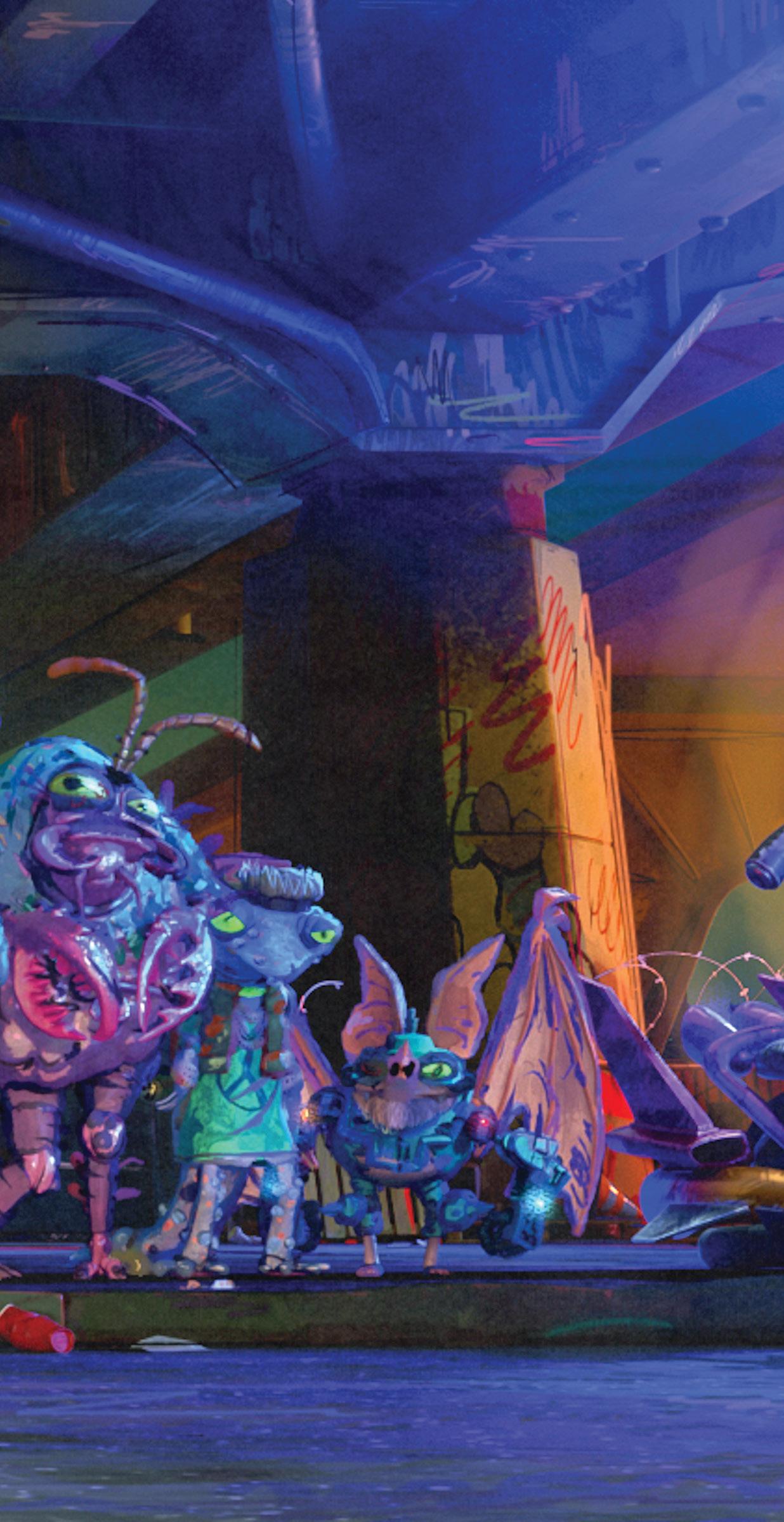
Krang, and a dozen more bad guys for almost 40 years. They can go another 40, easy. But Mutant Mayhem marks the first time these crime fighters take a few hard left turns, even in a franchise that always reinvents itself. By staying true to the first word in its name that is often overlooked, Mutant Mayhem features a new way of seeing these icons of childhood.
“There’s an emotional center, that is, what does it mean to be a teenager? That’s why we focused on it,” says Weaver. “We knew we could really connect with the audience. There’s a quick read to it. There are high stakes and high emotions when you’re a teenager. Everything feels absolute, even though it ultimately is a period of time. It feels forever.”
Says Rogen, “We tried to do these characters justice. We loved Ninja Turtles. This was made by people who have a genuine love for these characters. We wanted to make the best movie we could, so if you love them already, you’re getting something new and additive. If this is your introduction, hopefully, you’ll get on board right away and love them as much as we did.”
Playing with Ninja Turtles toys as children led Jeff Rowe and Seth Rogen to careers telling stories— stories that were sometimes gross but always heartfelt. “There are things [in the movie] that would excite me and make me want to play in that world and pretend I was in that world,” says Rowe. “The Turtles are funny. They’re not stuffy superheroes who fight for ideas you can’t understand, like justice. They feel like human beings, friends you want to hang out with.”
A teen slant to the Ninja Turtles echoes Rowe’s own adolescence. After growing up with the TMNT, Rowe found anime, an art form that doesn’t look down on its youthful audience.
“For the first time in my life, I was like, ‘This doesn’t feel like this was made for kids,’” he says. “That felt thrilling and exhilarating. This movie, by not trying to be all the ways animation traditionally is, hopefully it’ll inspire kids in the same way and make them feel seen.”
“IF YOU WERE A TEENAGE MUTANT RELEGATED TO THE SEWER, BUT FULLY INGESTING POP CULTURE, YOU WOULD WANT NOTHING MORE THAN A NORMAL LIFE.”

GET TO KNOW THE CAST OF TEENAGE MUTANT NINJA

TURTLES: MUTANT MAYHEM, FROM THE CORE FOUR
WHO ARE THE FIRST TO PUT THE “TEEN” BACK IN THE NAME, TO BELOVED ALLIES LIKE APRIL O’NEIL, AND BIG BADDIES SUPERFLY AND BEBOP.
Q:How did you and the other Turtles go about creating that sibling-like dynamic in your acting?
MICAH ABBEY: It was really smart to put us all in a room together when we were recording. Instead of just reading lines on a page, you get to bounce off each other’s energy and feel what the vibe is. On top of that, because we were together in person, we were able to spend time outside of the studio just hanging out as friends, and we really created a tight bond between us just because we spent so much time together in and outside of the studio.
What was a typical recording day like for you?
MA: They made sure that all four Turtles were either on a Zoom call or all together in LA, recording together. Whether it was with us and the villains or just us by ourselves, it was always with the other four Turtles to make sure we had that energy that we are constantly bouncing off each other. When we get together in the studio it’s all jokes…. It doesn’t even feel like work to me. We’re not even going directly off the script because they encourage us to improv a lot. We’re
just making our own jokes and adding things that we felt would fit. If I said something then Brady thought he could add something and then Shamon would add something and then Nicolas would add something and then we’d just keep on making it funnier and funnier.
What did you bring to the character of Donatello? Did you draw on your own experiences?
MA: I would say I’m kind of smart. I wouldn’t say I’m Donatello genius smart, but I took a lot of the characteristics of being inventive and intelligent from my friends. My friends are very smart and inventive. Donny, specifically, really likes K-pop and anime, and I have lots of friends who are very into those things. So I grabbed those personality traits from my friends. I also took parts from older movies and series in this franchise.
Donatello gets labeled as a nerd, but some fans have referred to him as “smooooooth Donatello.” Does he get to show off any of that smoothness in this movie?
MA: I think they’ll get a little taste of it, because Donatello is so intelligent that he gets to play things off really smooth. He’s a little bit of a show-off because when he does something right, he wants everyone to know it was done by him, and he’s the man. The smoothness definitely comes off in this movie.
What do you hope audiences will take away from the character of Donatello and your portrayal of him?
MA: That it’s okay to be nerdy. It’s okay to not be like your siblings or your friends. It’s okay to stick out sometimes for being yourself. Donatello is the one who sticks out most from his brothers because he’s more into technology than fighting. It’s important to remember that it’s okay to be the odd man out. It’s okay
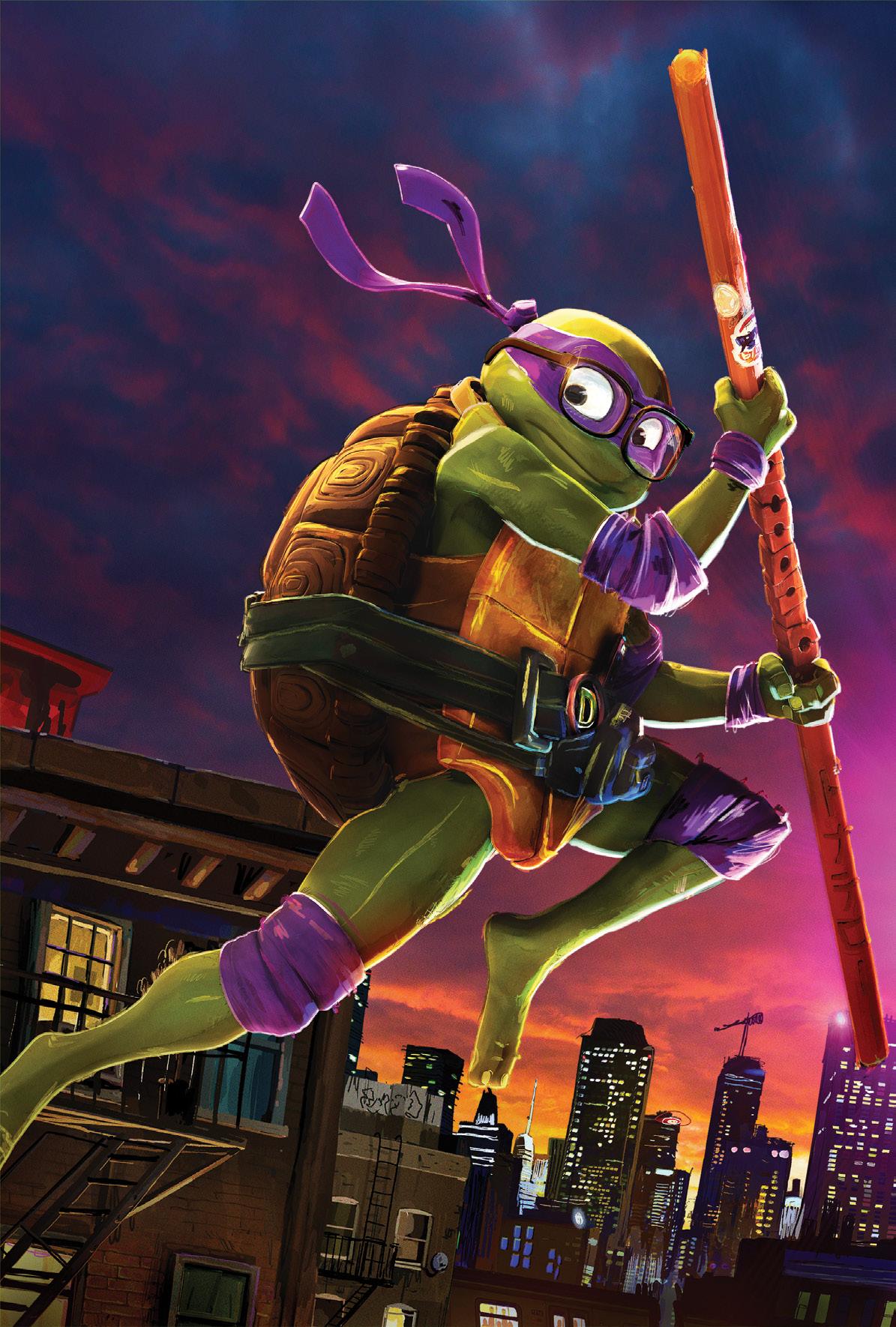
to be yourself. You will find a group that can relate to you.
What do you have to say to the longtime Ninja Turtles fans who are coming into this movie?
MA: Be prepared to have some laughs. Be prepared to have some fun. I know there are a lot of different versions of Teenage Mutant Ninja Turtles, and it’s good to switch it up sometimes. We kept a lot of the original stuff, but we added our own little spice to it. Be excited for this movie.

In the trailer, Splinter says that Michelangelo has “heart.” How would you describe him?
SHAMON BROWN JR.: He’s a family man; he loves his brothers. He loves pizza. He’s a party dude. He’s the funny one out of the brothers. But he is always there for his family and the people who love him. He’s reliable.
How did you and the other Turtles actors create that sibling-like vibe to your performances?
SBJ: Just talking. We have a group chat with each other, where we learn about each other and joke with each other all the time. That’s why everything you see in the movie is so authentic, because we’ve made that connection.
What was it like getting to record together with the other guys? What’s a typical day like?
SBJ: Chaotic, but fun. We are always cracking jokes whenever we have breaks, and even in the middle of takes, so the whole movie, it was just overall authentic brotherly love. In
What do you think of the look of the animation?
MA: When I first saw it I was literally freaking out in the booth. I was like, “oh, my gosh, this is gonna be the best animation of the year.” The animation is so unique and cool. Although there’s always gonna be different versions of Teenage Mutant Ninja Turtles, there’s always gonna be that same energy—but because of the different animation it adds a whole different feel. It brings a new character to the whole franchise.
the time that I’ve known these guys, it’s just been amazing and incredible. A lot of people don’t get to be in the same booth together. It’s kind of crazy, but it’s also fun at the same time.
What did you think when they said that, finally, the Teenage Mutant Ninja Turtles are going to be teenagers?
SBJ: I think it was just a sense of honor, just to have that opportunity
where we’re the first to do something. A lot of people don’t get to do that, so it was an honor and a privilege to have the opportunity.
Do you think that the Turtles feeling like outsiders makes them continually resonate with audiences?
SBJ: Definitely, because sometimes we don’t always fit into the crowd. That’s not always a bad thing, but as long as you can find your group of people that relate to you and feel exactly how you’re feeling or know what you’re going through, you can strive through anything. The Turtles have always been one of those things where they’ve never been accepted, but they’ve always had each other. Always having each other’s backs is an important thing that I think people can relate to.
How did you go about creating your version of Michelangelo?
SBJ: Back during the audition process, I didn’t want to do the
AS MIKEY
IT WAS JUST OVERALL AUTHENTIC BROTHERLY LOVE. IN THE TIME THAT I’VE KNOWN THESE GUYS, IT’S JUST BEEN AMAZING AND INCREDIBLE, AND A LOT OF PEOPLE DON’T GET TO BE IN THE SAME BOOTH TOGETHER.”
–SHAMON BROWN JR.
typical “surfer dude” voice that people are used to. One of the things I did was watch [animated TV show] Rise of the Teenage Mutant Ninja Turtles’ Michelangelo, who was played by Brandon Mychal Smith. I noticed that he didn’t do the surfer dude voice. So I was like, “Let me try to do my own thing with it.” And from there, I just made the voice how everyone sees Mikey now.
What do you hope that audiences will take away from your character after they see the movie?
SBJ: That he’s still the same Mikey he’s been after 40 years but that he’s a bit more modern. He’s a loving person and a loving Turtle. And that it’s okay to not fit in with the crowd. It’s okay to do your own thing.
What do you have to say to the long-term TMNT fans who are going to be coming into this movie?
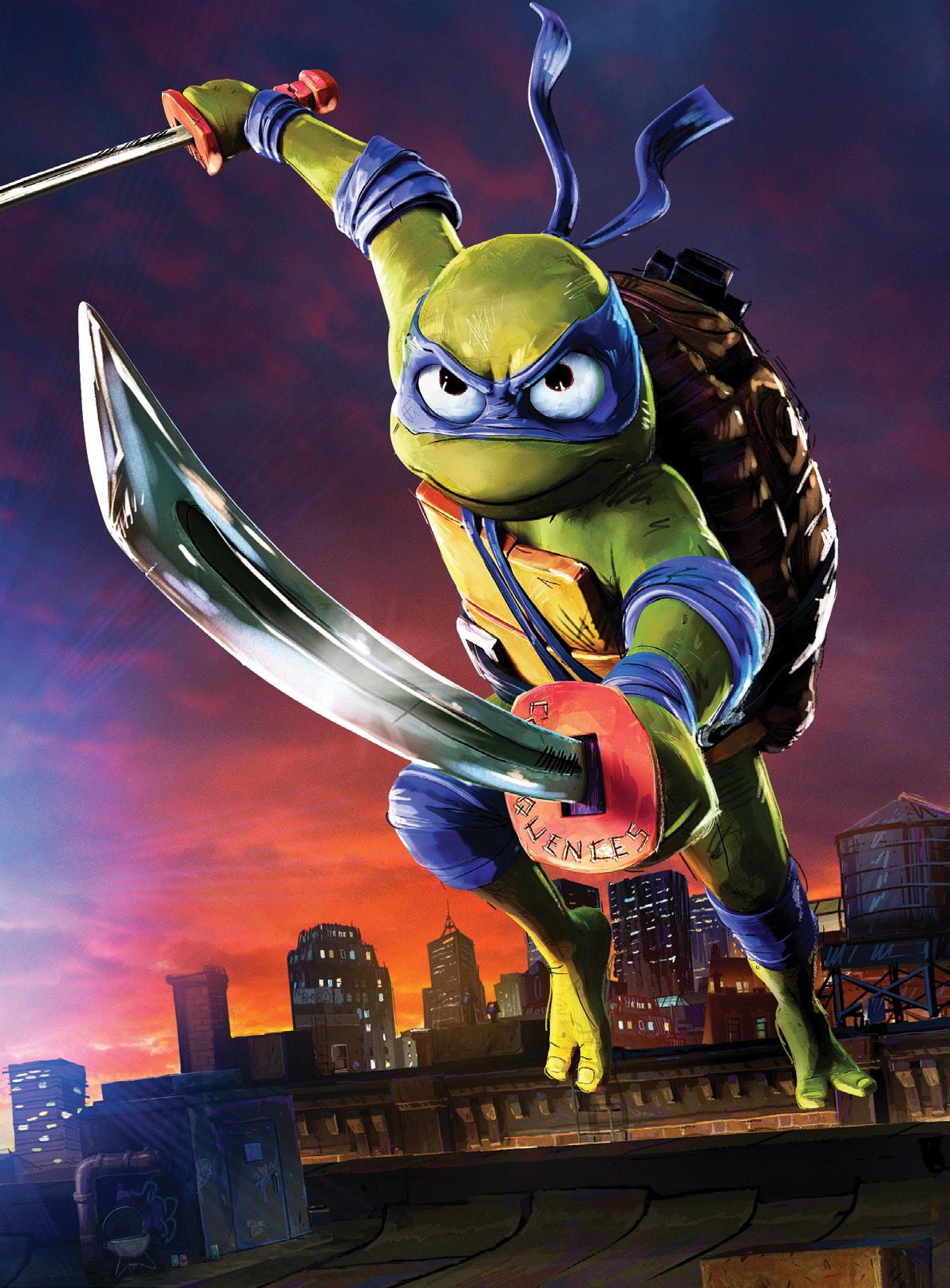
SBJ: I hope that I can make you proud. This has been a long time coming, and I’ve loved every minute, second, and hour making this movie. I hope you enjoy it just as much as you enjoy all the previous versions of Teenage Mutant Ninja Turtles.
Did you have a favorite scene you did voice work on?
SBJ: My favorite scene is probably [when the Turtles are] sneaking in from doing the watermelon video, and Mikey has this whole Pink Panther sneak thing. That’s my favorite thing that I did, for sure.
Are you excited about seeing it in the theater with other fans?
SBJ: I’m gonna see it every day that it’s out in theaters just because it’s my first animated movie as a lead and it’s gonna be exciting. Just to see people’s reactions to it, to hear all the loud bass and everything and feel the theater shake, and all that type of stuff. I’m excited.
What was your history with the Teenage Mutant Ninja Turtles franchise before you were cast in this film?
NICOLAS CANTU: My history with the franchise was seeing everybody in the schoolyard with Ninja Turtle backpacks or lunch boxes and kids bringing action figures to school. They became part of my world through merchandising. I just thought they were the coolest dudes ever since I was four years old.
Even just seeing them on backpacks made you go, “These guys are cool….”
NC: It’s wild because they really are very well designed and they bring out your imagination from your first sight of them. I have made up more about the Ninja Turtles in my head than any other fictional character.
How would you describe Leonardo?
NC: I would say the way that he’s different from his brothers is that even through all the turmoil of being a teenager, he still sees the end goal of having him and his brothers become this famous crimefighting team. He still has that dream, that’s the goal he’s working towards, and he’s the most serious. He’s still a teenager, so you’re always gonna be goofy. But he’s the one always trying to keep the brothers on track and he’s got a lot of anxiety because of that, I think.
Do you see any of yourself in the character of Leonardo?
NC: His position regarding his brothers is very similar to how I grew up. I was the middle child; Leonardo’s the oldest, so not that part, but the part where his brothers are getting up
to something and he’s the one trying to reel them in to behave. That was very much me growing up with my brothers. We’re very similar in that sense.
How did the four of you create the brother-like connection in your performances?
NC: I think [co-writer and producer] Seth [Rogen] really helped because he set the precedent for the banter, like, “We have the script. We love it, and it’s great. But if you guys want to step over each other? That’s how people talk. Not every line is delivered and then people wait to speak.” It’s this mishmash of a conversation that is so real. You get that a lot with brothers. People don’t let each other finish sentences. They try to get their ideas out before the other one. It’s a really brotherly thing to just disregard what somebody else is saying and say something completely different in the middle of it.
What was the audition process like for Leonardo?
NC: Although this was a voiceover project, and usually those auditions are just recorded through a microphone, they wanted to record me on video. They wanted to see my full body as I did the lines. I think they did that
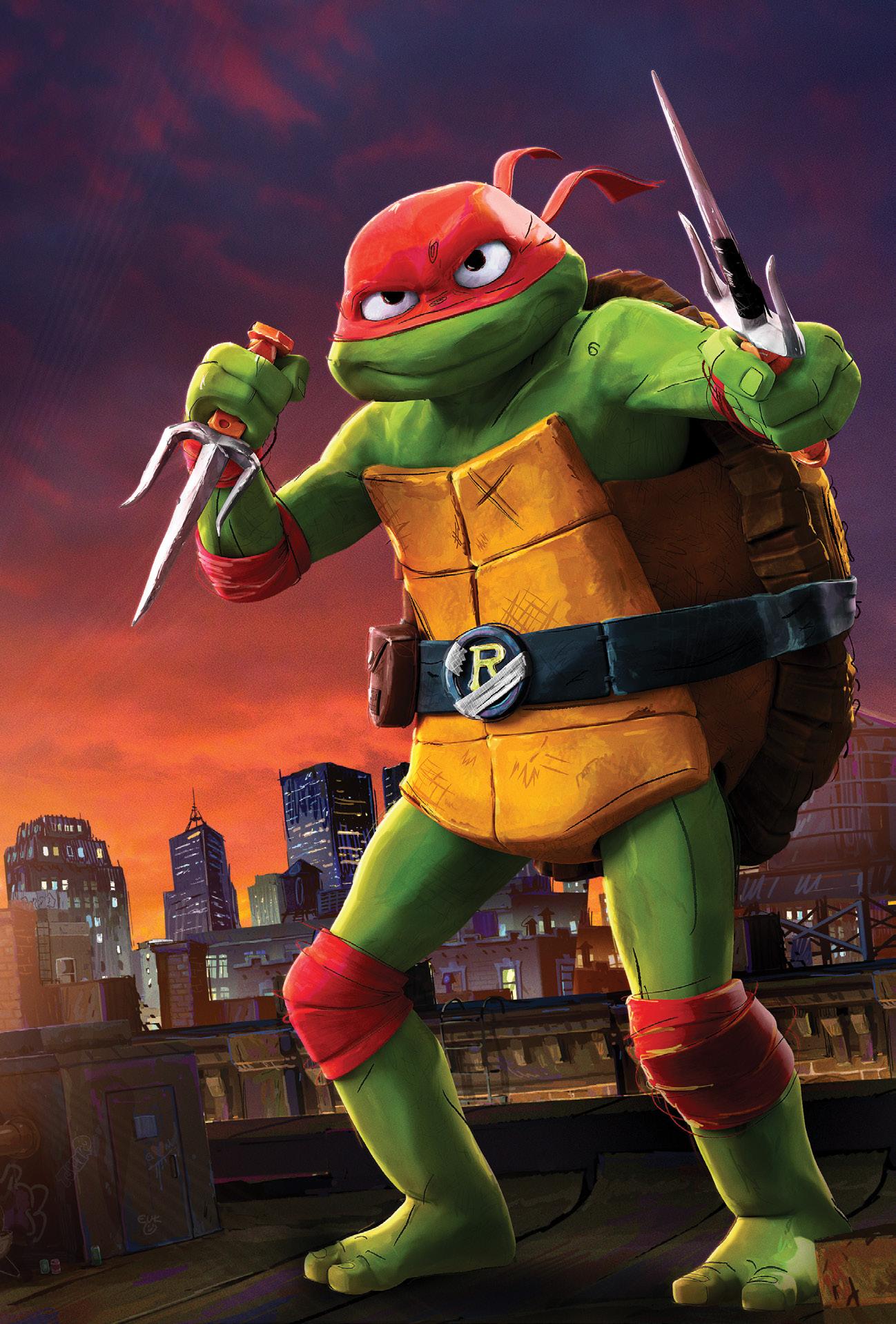
What were your experiences with TMNT growing up before you got this role?
BRADY NOON: Growing up, I was a huge fan of Turtles. I watched the 2012 version on Nickelodeon, so that was my jam. Now being able to be a part of it is just a dream come true.
because they just wanted to see more of my personality. When you’re recording your voice, you can kind of get a “character” coming through. I think casting wanted to see who the kid behind the voice would be. But it was also really silly because they asked us to do 30 seconds of dancing. I just remember thinking, when are they ever going to use this? Why do they need to see me dance for a cartoon? But I busted a move, and now here I am as Leonardo. It was the dancing that did it!
Are we going to see Leonardo bust a move in this movie?
NC: Yeah. They’re Turtle boys—they love to dance, they love to celebrate, they’re teenagers…. They’re going to be moving.
What do you think of the way the movie is animated?
NC: The first time I saw anything complete it was like a camera test that they did, and I think it was Donatello, just on a skateboard skating through the city, and it looked incredible. Mutant Mayhem has got this hand-drawn feel to it. It’s like if you took a note or a page out of some kid’s textbook that he doodled on in the corner. There’s stuff like that in the visual style and I thought it was sick. I was already excited to be a part of a Ninja Turtles thing and play Leonardo, but then I saw the first little glimpse of what it’s actually gonna look like and my excitement just skyrocketed because I’m a sucker for cool animation and it looks sick.
In the trailer, Splinter describes Raphael as having “bravery.” How else would you describe the character?
BN: Raphael has definitely got a mixture of everything. I mean, there’s definitely some bravery in there, leadership, and a lot of heart as well. A lot of people forget about that because Raph is such a hothead. Raph’s leadership gets developed more and more when necessary.
Do you think that the Turtles feeling like outsiders makes them continually resonate with audiences?
BN: I think so. Audiences will definitely be able to connect with characters that are different or unique. Something that I hope people take away after watching the film is that it’s okay to be different. Sometimes even the most unique people can be heroes.
How did you and the rest of the turtle cast go about making it feel like you were really lifelong siblings? It definitely comes across in the trailer.
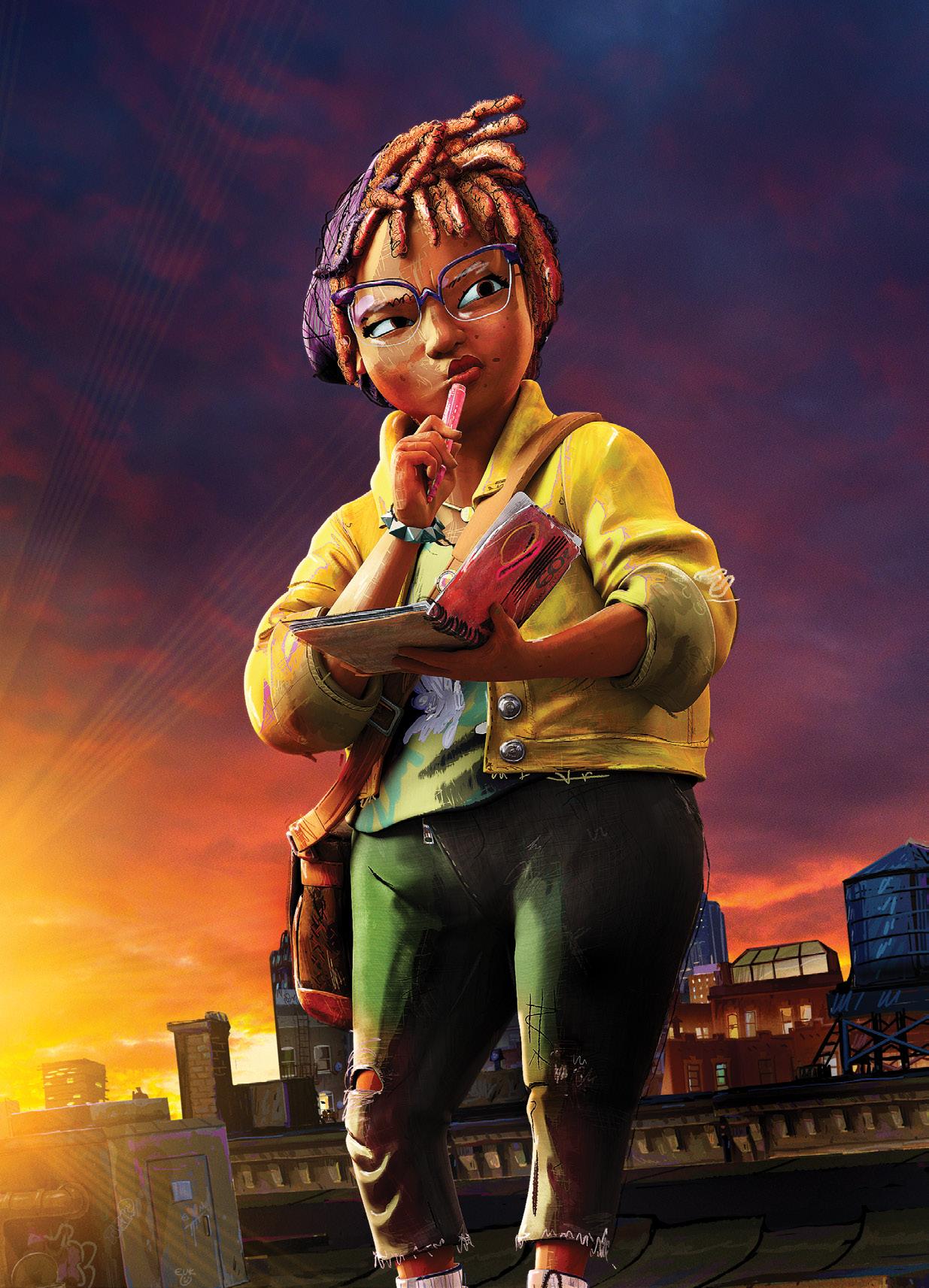
BN: The first time that I met all the Turtles actors was in a chemistry read and we just kind of knew right there when the four of us were trying to read the script. The producers and the people at Nickelodeon and Paramount were just cracking up. We all knew at that point we had something special. Working on this in the last two and a half years or so, I’ve seen the other Turtles actors every week. It’s like these guys have become my brothers in a way
Did you guys ever ad-lib dialogue? There’s such a flow to the way you all talk together.
BN: A lot of times we would start recording and [co-writer and producer] Seth [Rogen] would be like, “Argue about a topic related to TikTok!” And in character we would start arguing and we’d just riff and see where we’d end. We know when it’s a safe place to ad-lib and when to not. The movie is actually hilarious and it’s partially because of the improv.
Your versions of the character seem like the most teenage these characters have ever been. What’s that been like?
BN: Us being actual teens and us putting forth our actual experiences being in this new generation, we got to be hands on with this movie. Seth and Jeff Rowe would ask us, “What’s new?” We’d consistently talk about certain slang that we’d use nowadays and incorporate that so it’s relatable to people our ages.
How would you describe this film to your friends and family?
BN: It’s action-packed, lighthearted, exciting, thrilling, hilarious. It has got everything. So grab your popcorn and enjoy.
Was there anything for you that was particularly challenging?
BN: Any of the fight sequences. It’s so
hard to match that animation! I will be fully acting out in the booth as if I’m on camera. Just to get the authenticity of me running through the woods. “Now jump.” So now I have to jump. So I’ll be like [makes running noises] and then start running again. I haven’t done a lot of voiceover work. I’ve mainly done live action. This was definitely a challenge for me. It definitely took me out of my comfort zone. But I eventually thrived and I love it.
Were there other things that Micah and Nick and Shamon were doing that you were copying?
BN: We were throwing fists in our own little corner of the studio. Nick, who plays Leonardo, had his own guardrail for his recording sessions because he gets really into it. He’d just grab it and shake it. So we gave him a little rail. Here you go, have this.
How would you describe April?
AYO EDEBIRI: April is a young high school student. She’s dealing with a lot, she’s got a lot of feelings and a lot of things she wants to do, but she doesn’t always have the confidence that she might present at first…. She’s a very dedicated journalist, and she wants to get a good story. As soon as she meets the four Turtle boys, she’s like, there’s something here; I gotta crack this.
Why is she so important to the Turtles in this film, and why are they important to her?
AE: April and the Turtles really help each other, and they find each other in spaces where they really need friendship. It maybe starts out as a bit more of a transaction. The boys are like, “We wanna be cool and know a human.” And she’s like, “I wanna win a Pulitzer.” But they’re just beings who are looking to belong and looking for friends.
Talk about the energy performing with these four teen boys.
AE: It was an unforgettable experience;
being in a room performing with four teenage boys who were just sort of talking and making jokes. It really was so cool and so helpful for me because I think something that [co-writerdirector] Jeff Rowe and [co-writer and producer] Seth Rogen really wanted to prioritize in this iteration of the movie was the fact that they are teenagers… and the energy of the boys is just so infectious. You can’t really replicate that, the way that they bounce off of each other. I feel like it gave me more leeway when I would be with them or when I would do a recording with something that they had already recorded to sort of figure out how April would speak and respond in that situation. It just left room for a lot of play, and I think the sense of humor feels really authentic because of that.
What is different and interesting for you about this project, as opposed to the movies, cartoons and comics in the past?
AE: I think the thing that stands out to me the most is that they feel like real teenagers in a real New York City, and
How would you describe Superfly?
ICE CUBE: Superfly is the most gorgeous creature ever known to man. I mean, as a mutant, he’s the most beautiful thing you’ve ever seen.
Superfly is an original character for this iteration of the Ninja Turtles. Can you explain how he is created in the film?
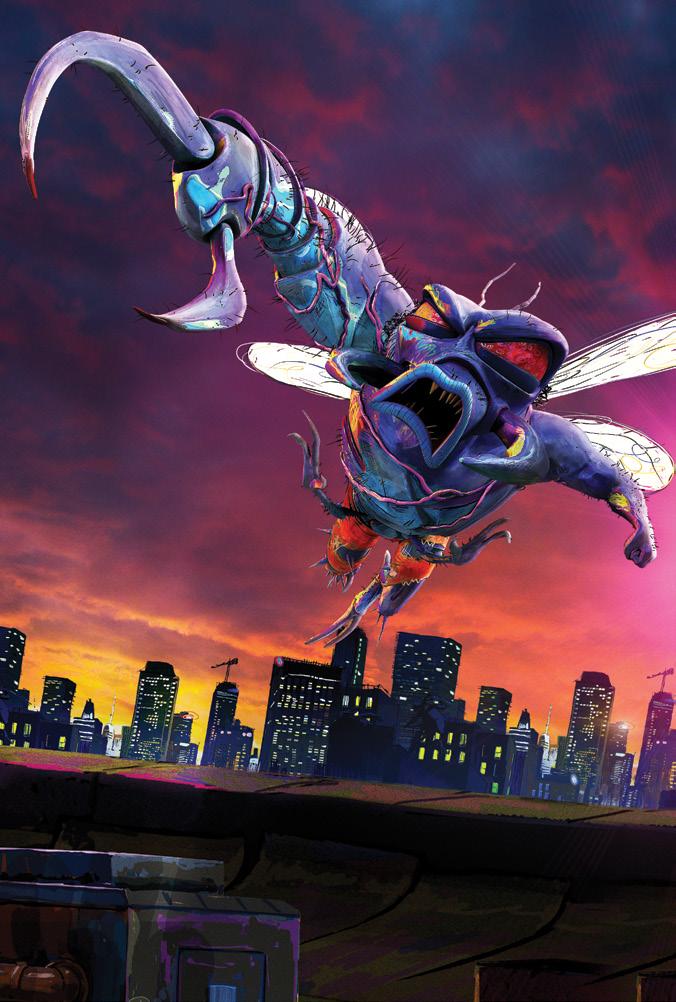
IC: Superfly is created through an experiment. His father is one of the most brilliant men ever. So he was experimenting, it went a little wrong; the police had to rush him, and it got
a little mishandled. I don’t want to give too much away, but Superfly was born from that mishandling.
Were you excited when you got the call for this, and they explained to you that you were going to be playing an original character?
IC: The franchise has been around as long as I can remember, it seems like. So to be a part of it in any way, shape, or form, I knew it was a cool opportunity. I knew with Seth Rogen [on board] that it would have some
that sense of life and fun is so active. There are so many comedians and incredible talent and really funny people involved on every side of the project, from writing and directing to acting, so I think people’s individual senses of humor were really allowed to shine. But also, the sense of humor of the project was really allowed to find its voice organically and in a fun way.
Talk about the visual style and your impressions of it.
AE: Just seeing something that’s so distinct, authentic, and unique is always really exciting. And I think it just looks gorgeous. But, also, the way that Jeff talked about using the camera and capturing sort of a handheld feel, capturing the feel of when you watch a skate video, how the camera is very dynamic and always moving was really exciting.
What’s your own past with the Ninja Turtles?
AE: I have maybe 50 cousins, and like 40 of them are boys, so growing up, I was very well versed in Turtle culture. I actually showed Jeff and Seth my first skateboard. My skateboarding career is long over. But my first board was a Teenage Mutant Ninja Turtles deck—it was a Michelangelo deck. So I was a big fan.
edge to it. It would be clever, fun, and fresh. I was really excited to be able to play a supervillain. Who doesn’t want to play that in a movie?
What do you think of the animation style?
IC: I think the illustrations, the animation, and the flavor of the movie are just as exciting as the story. It’s fresh. It looks amazing. We’ve seen so many animated films by now, so to see somebody take it even further and give you something even fresher than what we’ve seen already…. The style, to see the way they used lights and colors. That’s what I’m here for.
How were the voice sessions different from others you’ve done in your career?
IC: It was really about: do what you feel, and we’ll get the lines down, but we really want you to ad-lib and have personality and not just stick strictly to the script. I think that lets you loosen up. They don’t discourage anything. I think when you’re doing a voiceover, you have to show not only the director, not only the producer, but you’ve got to show the audience why they hired you.
What can you tell us about Superfly’s crew of mutants?

IC: At the end of the day, they all want to be liked, you know what I mean? They just want friends. They want it
so bad they’ve gotten bitter. Usually, with a movie like this, when you have a second wave of characters coming in, they can get lost in the sauce. But here everybody made a great impression.
If Superfly could have his pick of what borough of New York City to live in, where would he live?
IC: Superfly is either a Bronx guy or a Brooklyn guy, you know what I mean.
What did you think of Jackie Chan as Splinter in the film?
IC: He’s the heart of the movie. I just wanted to hear him talk; to hear him give his philosophies on how things should be. It was perfect casting, and he brought the heart to the movie.
What do you have in common with Superfly?
IC: He’s a cool supervillain, and I’m a cool supervillain. He’s somebody that, when you get to know him, he’s probably a party animal, and you could hang out with him. I’m the same way. I think we’ve got a lot in common.
What is your history with the Teenage Mutant Ninja Turtles?
SETH ROGEN: I grew up watching Teenage Mutant Ninja Turtles. The animated series came out in 1987 when I was five years old. And then the live action movie came out in 1990. I was eight. So it was perfectly geared towards someone my age, and I loved it. They were funny; they made a lot of references I honestly didn’t understand, and in retrospect were even outdated by the time they were making them. I started taking karate [classes] probably because of the Teenage Mutant Ninja Turtles. My dad bought me nunchucks because of the
AS BEBOP I WAS REALLY EXCITED TO BE ABLE TO PLAY A SUPERVILLAIN. WHO DOESN’T WANT TO PLAY THAT IN A MOVIE?”
–ICE CUBE
Teenage Mutant Ninja Turtles. I was just kind of obsessed with them.
Why are you playing Bebop?
SR: I only play warthog-type creatures. I had this funny idea of Bebop and Rocksteady being two angry, New York bros. I love John Cena and so yeah…. Whether I was Bebop or Rocksteady was ultimately, you know, somewhat interchangeable in my head. But the idea of being a part of the Bebop and Rocksteady team with John was something I knew that I wanted.
What else can you tell us about him?
SR: I mean, honestly, [Bebop and Rocksteady] are just kind of angry New Yorkers. Part of the joke is that Superfly has kind of dysfunctionally raised this family of mutants, and throughout the movie, you’re seeing them realize that all these issues they have in their lives are maybe due to their bad upbringing, which is also kind of a theme in the film. But yeah, this idea that Bebop and Rocksteady are kind of best friends and a little co-dependent but also both incredible rageaholics that are slowly realizing that they’ve been raised poorly was a very funny idea. Just to see them be like angry New York bros was really funny to me, as well.
Did you record in the same way that all the turtles kids recorded together? Did you record with John Cena as Rocksteady?
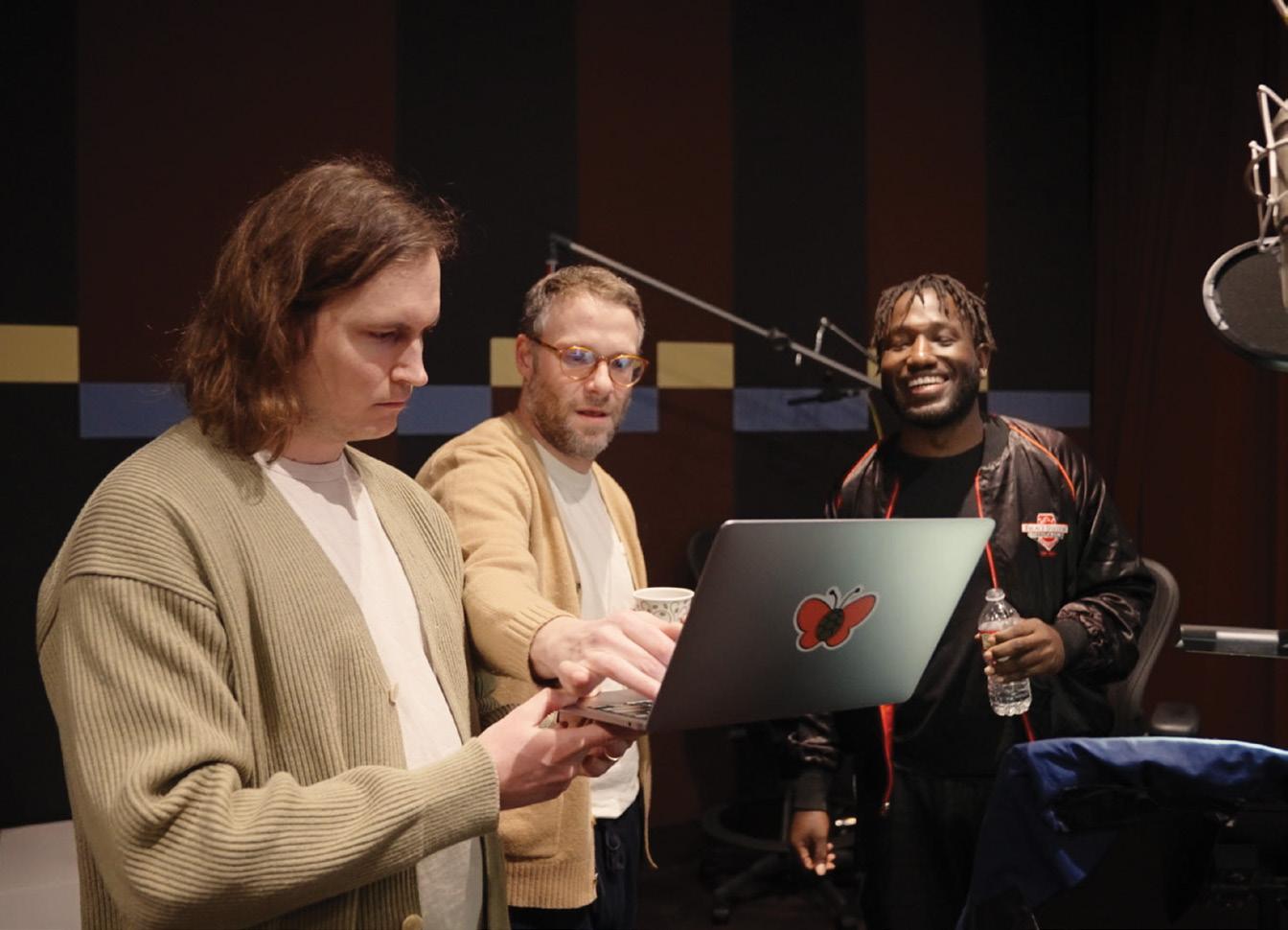
SR: Yes. We weren’t always in the same city, but we recorded over Zoom together. I think we did one that had me, all the turtles, Ice Cube [Superfly], Rose Byrne [Leatherhead], and Natasia Demetriou [Wingnut] all at the same time. Any time we did a recording session I would just be like, “Get whoever is available who is in these scenes and have them try to participate,” because it just adds so much to it.

Was there any contrast with the dynamic of the kids playing the Ninja Turtles in them interacting in the same space when you got all the mutants together? What was the vibe?
SR: It was fun! It was silly and goofy and I remember Rose Byrne screaming like a maniac in this Australian accent. Everyone is just so funny and we really had fun with it. I think part of the spirit that we were trying to capture honestly was to make the movie fun and to give it this wild energy. That was something that we talked about: how do we make it feel fun and silly and obviously have a good story and good plot and all the things that the movie needs to have, but also have this kind of reckless weirdness that’s almost like a kid playing with their toys.
How do you voice a character like that?
SR: I watched every season of Jersey Shore. I love it. So, yeah, kind of like an angry, aggressive Jersey Shore guy was where I started.
Director/co-writerJeff Rowe and co-producer/ co-writer Seth Rogen in the studio.
THIS IDEA THAT BEBOP AND ROCKSTEADY ARE KIND OF BEST FRIENDS AND A LITTLE CO-DEPENDENT BUT ALSO BOTH INCREDIBLE RAGEAHOLICS THAT ARE SLOWLY REALIZING THAT THEY’VE BEEN RAISED POORLY WAS A VERY FUNNY IDEA.”
–SETH ROGEN
Teenage Mutant Ninja Turtles: Mutant Mayhem brings back the iconic reptilian quadruplets for another wild adventure in the animated world of New York City. But for this story, director Jeff Rowe and writers Seth Rogen, Evan Goldberg, Dan Hernandez, Benji Samit, and Rowe himself bring two new ideas to the screen: casting
BY KEVIN JOHNSONactual teenagers as the Turtles themselves and applying their own unique spin on the current trend of stylized, exaggerated visuals, jump-started by Spider-Man: Into The Spider-Verse and continued with Puss in Boots: The Last Wish and The Mitchells vs. The Machines, which Rowe also co-wrote and co-directed.
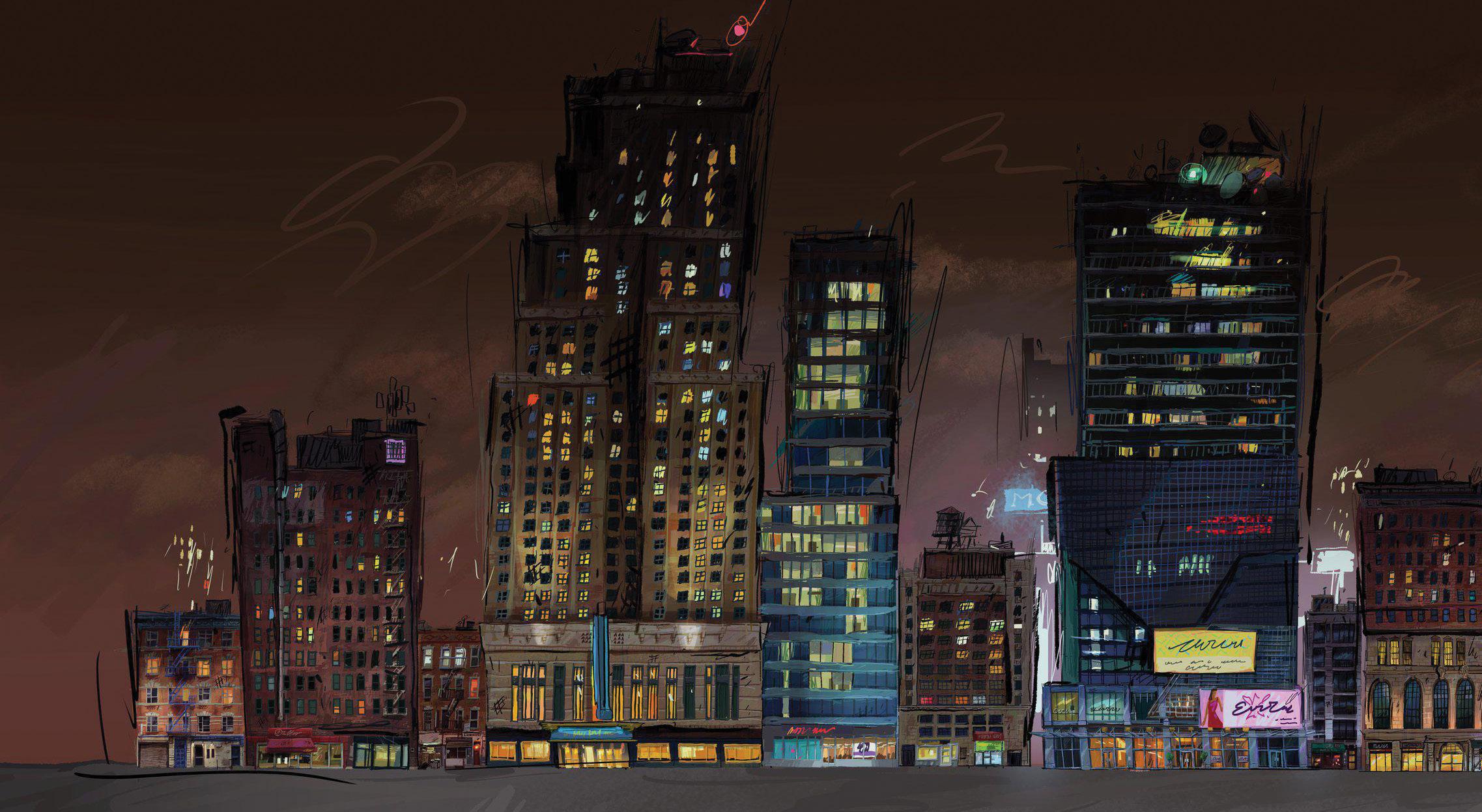
Still, there’s a plethora of Teenage Mutant Ninja Turtles visions out
there: several comics, more than five different TV shows, and six movies, not to mention the churn of toys and merchandise that have spawned from Kevin Eastman and Peter Laird’s original creation. Mutant Mayhem seeks to stand out by emphasizing the youthful adolescence of the turtles, not just by casting teenage actors to play the heroes, but the very visuals themselves—the animation, the shot selection, the colors—are meant to support this radical take on the familiar coming-of-age story.
Kent Seki, Mutant Mayhem’s head of cinematography, wants to emphasize the ephemeral youthfulness of the main four by keeping the camera close, handheld, and alive. “We shot it with a handheld style, almost like [you’re] on the run, [as if] you’re hanging out with your friends, they’re goofing around, and they ended up kicking the skateboard into the window or the door of the bodega, and they have to run off. That’s what we all did when we were teenagers getting into trouble. And that became
a source of inspiration.” Seki sought to utilize a “cinema vérité” style to film Leo, Raph, Donnie, and Mikey as they engage in their antics, both comedic and action, with the seminal work of Emmanuel Lubezki and Spike Jonze informing that look.
The film’s lead character designer, Woodrow White, goes even further when describing the individual look of each sibling, moving away from the “mono-style except by mask” of the classic Teenage Mutant Ninja Turtles and applying elements to truly showcase the four heroes as young, budding teens.
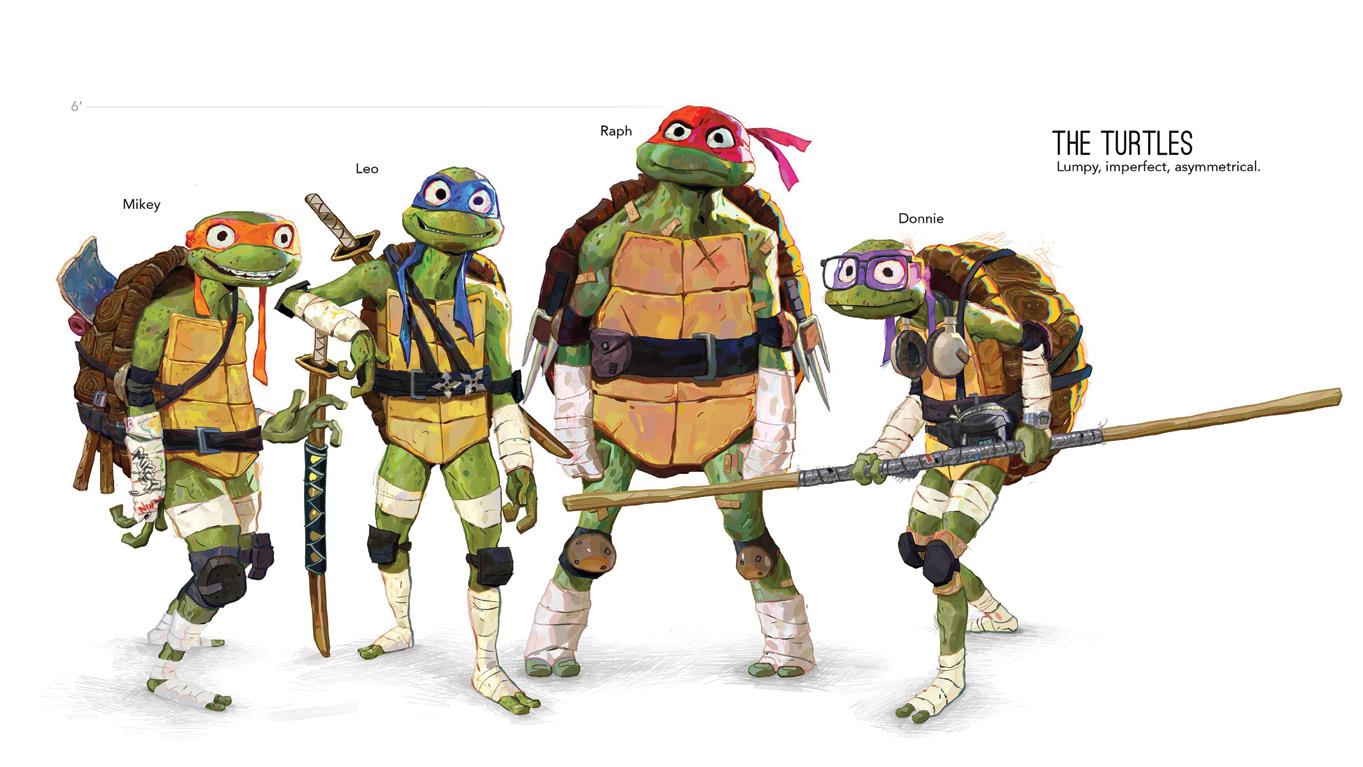
“Jeff and I were on the same page with the Turtles, the ‘teenage’ being emphasized in the Teenage Mutant Ninja Turtles—we wanted them to sound and look like teenagers,” White says. “So we were always pushing for a less bulky version of the Turtles compared to the previous versions…the vision in our head was that we wanted something new and fresh and more relatable. We always had in mind a slightly skinnier version of the Turtles, kind of more teenage builds.”
White even expands on some of the finer details of some of the brothers. “We always knew we wanted Donnie to have glasses. It’s just he’s commonly [known as] the brainy one,
but also, I just think a Teenage Mutant Ninja Turtle [wearing] glasses is funny. Not necessarily as a defining trait of wisdom or geekiness but rather a defining trait of adolescence. Glasses on Donny, braces on Mikey… they’re all these sort of visual growing pains that we can all relate to being a teenager.”
The Turtles’ adolescent narrative journey is meant to butt up against the adult world, at once steady,
confusing, and… well, ugly (but in a good way). If the Turtles’ world is shot to look spontaneous, reactive, and “in the moment,” the adult world around them is more controlled, formalized, and grounded.
“What we wanted to do was contrast the handheld Spike Jonze of it all with the kids,” Seki says. “We took another inspiration from early Paul Thomas Anderson [and] his work with [cinematographer] Robert Elswit on Boogie Nights, where there’s a more formal camera language. So, we have the spontaneous, where you’re just trying to follow the action, and then we have the more formal, camera-driven world of PTA. Those two worlds are separate.”
Seki continues: “When we shot scenes, we would use these different techniques to support the subtext of what was happening. So if the kids were being reprimanded by Splinter, [we] would be much steadier with the camerawork, and then when we cut back to the kids, they’d be a little bit more handheld, a little more loose, and those kinds of things started to creep into the cinematography. So we had this dichotomy of the teenage world and the adult world.”
Both worlds are a treat to look at. Spider-Verse may have kickstarted the new wave of hyper-stylized CGI animated films, but Mutant Mayhem has a style all its own, with an overall visual look that came from a fairly unlikely place: a teenager’s sketchbook, a “design philosophy” that production designer Yashar Kassai describes as “draw like you’re 15,” “be emo and cringe,” and even

IN THE CURRENT ANIMATION LANDSCAPE OF PERFECT AND SYMMETRICAL CHARACTERS, IT’S REFRESHING FOR US TO PURSUE SOMETHING SO IMPERFECT.”
–YASHAR KASSAI, PRODUCTION DESIGNERLeft: Concept art for Mutant Mayhem’s take on New York City. Right: The four Turtles were designed to look like actual teenagers, with a scrawnier, more imperfect look than we’ve seen before.
“draw very serious things but add levity by drawing them shitty.”
“A lot of this film’s look is inspired by my own sort of loose sketching and painting style,” says White. “We wanted it to resemble the looseness of not only my work but also of teenagers’ work—the way a teenager might draw in a sketchbook, all these crazy monsters and people.”
“We’ve all been young, untrained artists in class doodling in the margins of our notebooks when we should have been paying attention,” Kassai says. “I think that it’s very relatable. In the current animation landscape of perfect and symmetrical characters, it’s refreshing for us to pursue something so imperfect.”
Indeed, New York City in Seki’s camera looks sketchy, scribbly, and asymmetrical, like what any kid might draw in the margins of their notebook, but with a full-fledged studio budget behind it. Offbeat and slightly askew NYC iconography fills the screen with vibrant but familiar colors, turning the skyscrapers, streets, and sewers into a playground from a kid’s imagination.
“I can definitely say that one of the big color influences were the toys themselves,” Seki says. “I feel like we chart our own path, but there was amazing attention paid to the color
palette of the toys, the chunkiness of those toys. Even the color palette of the original cartoon series was very influential on the film itself. And even in the beginning, when they have the white eyes, it’s very much a nod to the comic book…. So there are little elements of that throughout the whole movie.”
“The amount of detail layered onto every mutant character in that [original toy line] was insane,” adds production designer Yashar Kassai. “As for the movie’s lighting and color, it oscillates between authentic New

York nights and surreal alien color schemes. The photography of Alex Webb is a strong influence.”
To be clear, trying to apply so many of these ideas—the live-action camera language, the “teenage sketchbook” look and feel, the point-of-view of a much younger take on the Turtles—proved to be quite a challenge. Or, at least, a different challenge.
“It’s not that one is harder than the other; it’s a different problem to solve,” Seki says when describing how to apply live-action principles
WE WANTED A FRESH NEW SPIN ON THE TURTLES, BUT WE ALSO WANTED TO BRING THE ENERGY OF THE TMNT TOYS FROM THE ’80S AND ’90S.”
–WOODROW WHITE, LEAD CHARACTER DESIGNER
to animation, much of it in various stages of completion. “We have to make sure that the camera feels authentically real, and creating that realism in the camera is very challenging with a CG-perfect camera. How does the camera start moving? How does it stop? Does it have a jostle in it? We had a moment in the making of the movie where we had tried to infuse this live-action handheld feel. It feels weird, especially early on in the animation process, because you’re working with previz characters in previz animation, which isn’t complete, so it’s very wooden. If there’s a camera with a lot of movement and then you pair it with wooden animation, which will eventually be replaced, it feels strange.”
Seki recalls: “We actually went to a screening room in Nickelodeon, and I brought a ton of live-action references that [utilized handheld cameras]. When we watched it and then watched our sequence, Jeff [Rowe] said, ‘You know, this is really going to have to be a leap of faith. We have to believe that this camera that feels a little jarring right now will work when it has the final animation, which will be months later.’ That alone says something about how difficult it is to really know what’s
going to work. We had to take that leap of faith.”
No doubt the Mutant Mayhem team hopes that audiences will take their own leap of faith when the film drops this August. But the balance between the original depiction of the Teenage Mutant Turtles and the more updated version on display has been carefully, craftily curated. “We
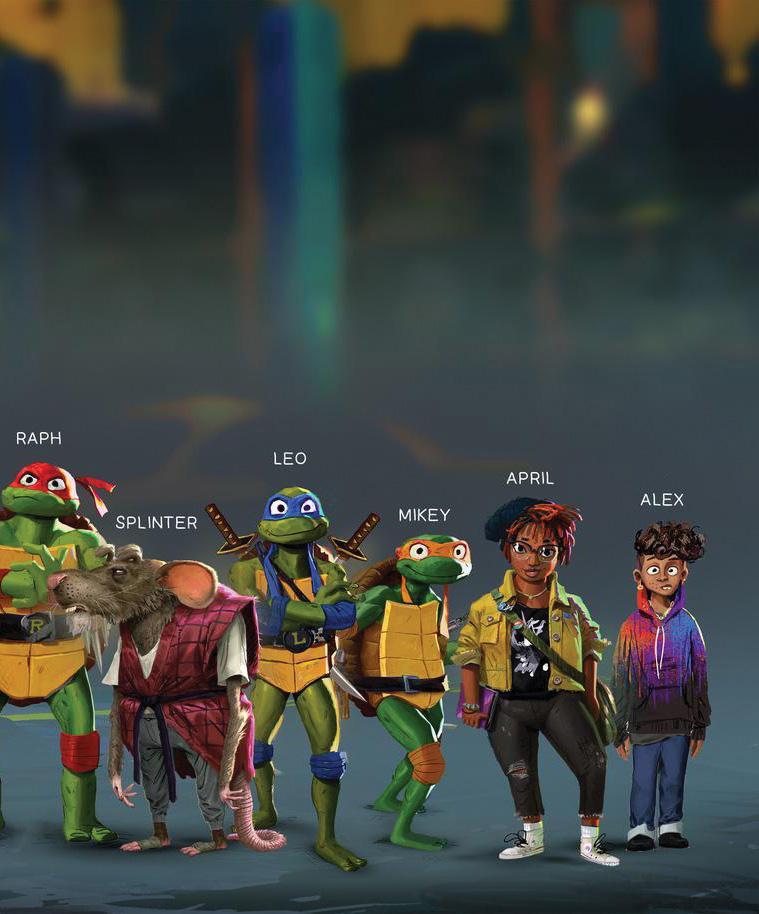
wanted to bring a combination of new and old,” White says. “But what I mean is that we wanted a fresh new spin on the Turtles, but we also wanted to bring the energy of the TMNT toys from the ’80s and ’90s. The creepy, gross-out visual aesthetic that I loved as a kid, and energizing it with this new contemporary style.”
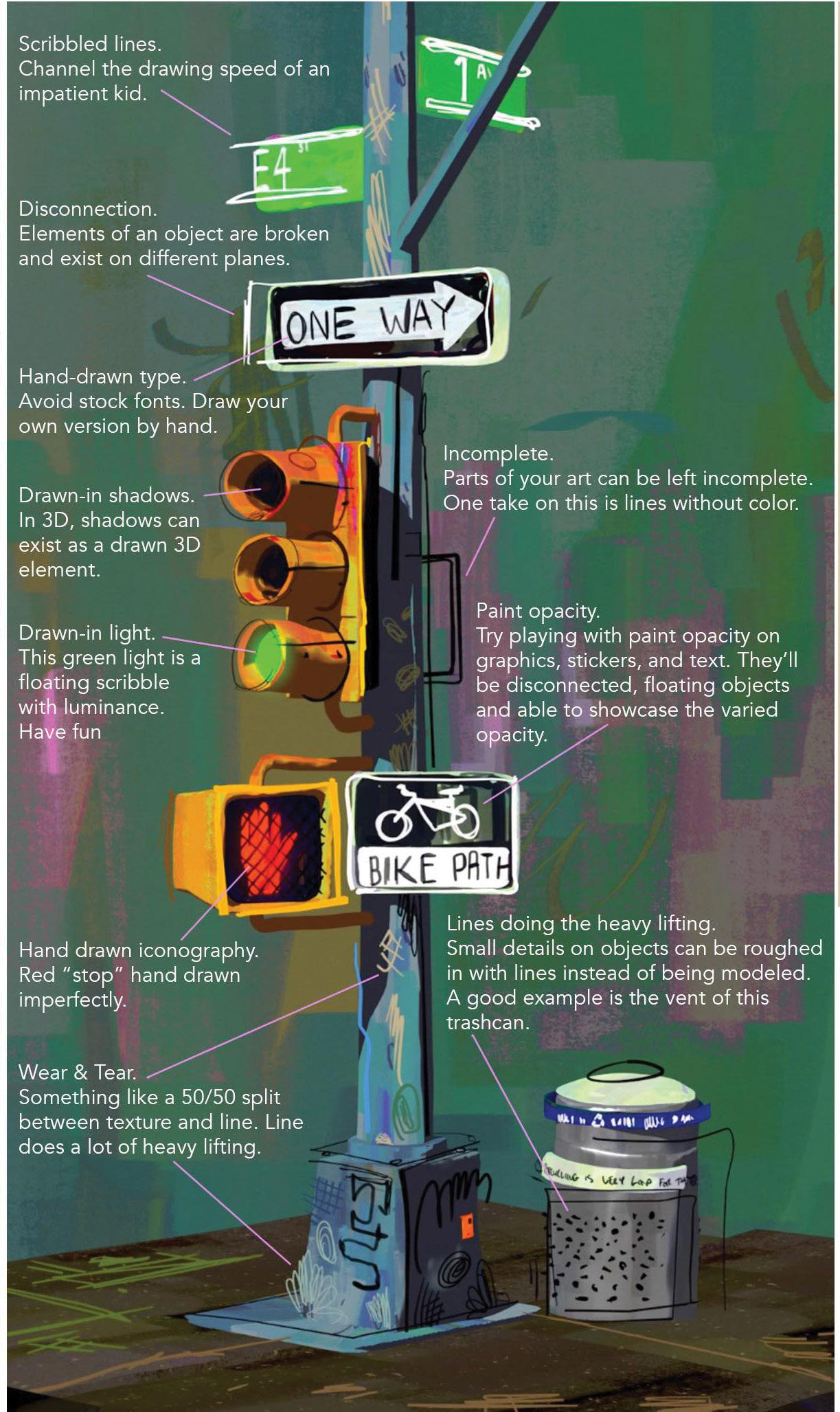 Character designs for the animated cast of Mutant Mayhem, featuring a bold new take on a line-up of classic heroes and villains.
Character designs for the animated cast of Mutant Mayhem, featuring a bold new take on a line-up of classic heroes and villains.
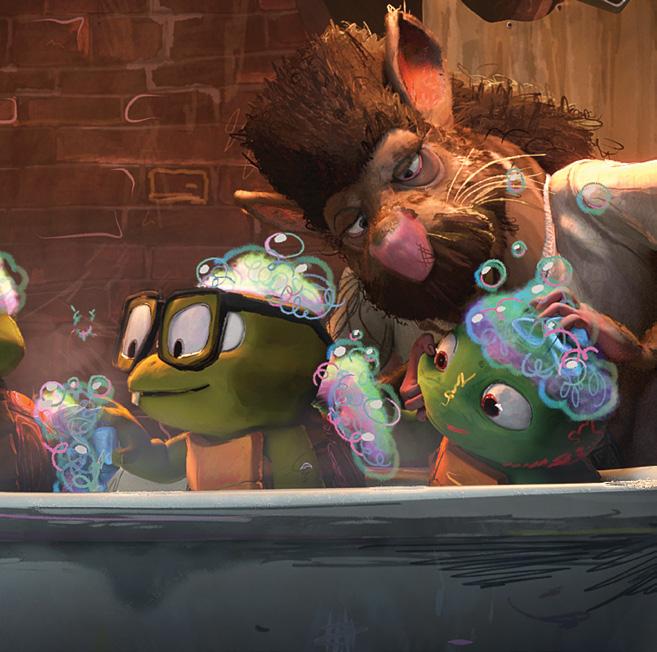
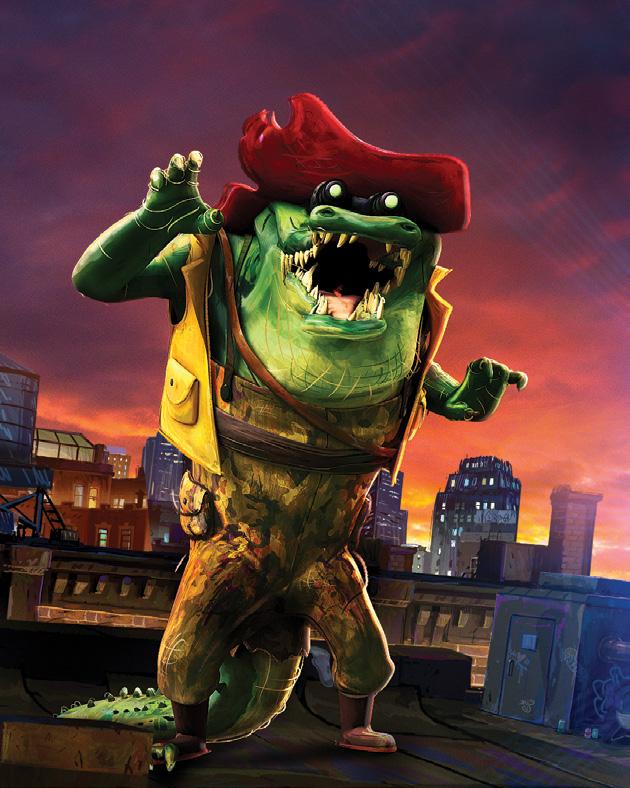
“We wanted to lean into the dad aspect of Splinter in Mutant Mayhem. He’s very disheveled looking from the stresses of parenthood. But he’s still a ninja master, so he wears a kataginu that he cut from a discarded bathrobe. This reflects his improvisational, D.I.Y. way of life. He’s working with what’s available in the sewers to create a comfortable environment for him and his four sons. And then there’s the sweatpants, which are a common staple of stay-at-home parents. Jeff Bridges’ The Dude character from The Big Lebowski was a big fashion inspiration. Splinter’s build was partially inspired by Danny DeVito, with his short stature and long arms. One gripe I had with Splinter in many different versions of TMNT was that he wasn’t ever quite authentically ratlike enough. So I studied a lot of photos of rats.”
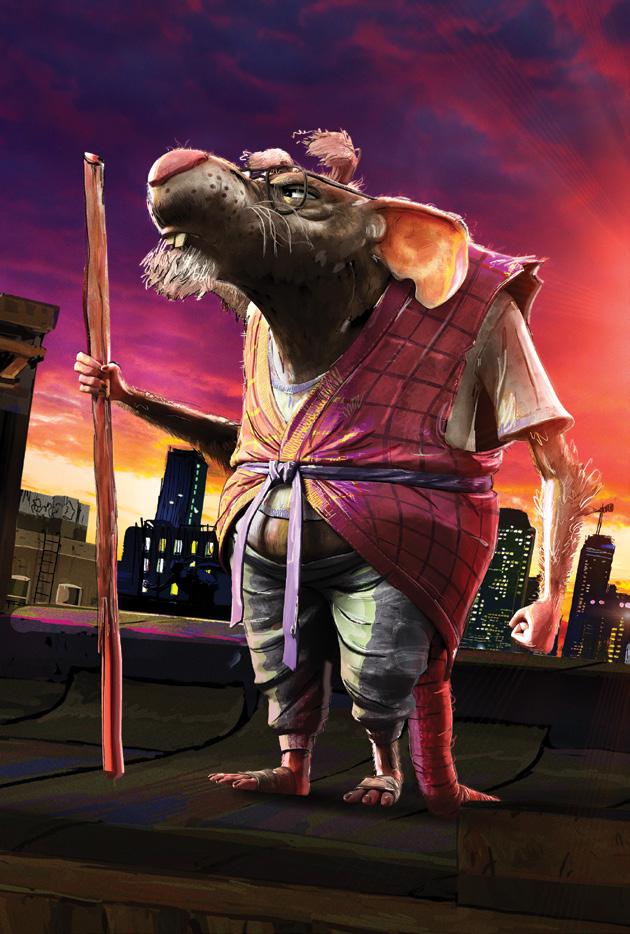
“I didn’t want to make Leatherhead muscular because I felt like I was leaning too much into Killer Croc territory, the Batman villain…. I just started sketching out an alligator, and I started asking myself what an alligator would look like if it could stand on two legs. And so that’s how you get that upside down L structure to the character composition…. I feel like a more humanoid alligator wouldn’t look quite as funny carrying a shotgun the way an almost-alligator looks carrying a shotgun and hunting goggles.”
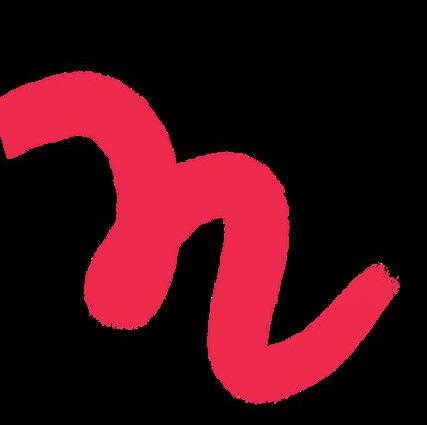
“Our production designer Yashar Kassai helped out a lot with this one. I knew one of my desires in creating Genghis Frog was to make him a pixie frog [another name for the heavy-set African giant bullfrog]. I don’t know if you’ve ever seen one before. But one of my goals was to use a pixie frog as a basis for Genghis. I did some sketches, and Yashar did some sketches. And I think Yashar really tied that one together himself.”

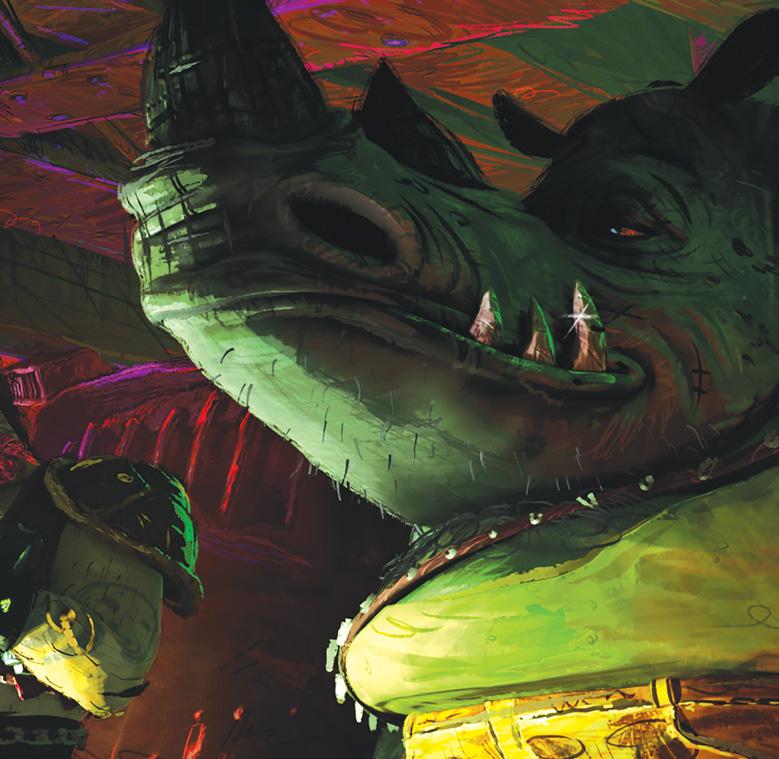
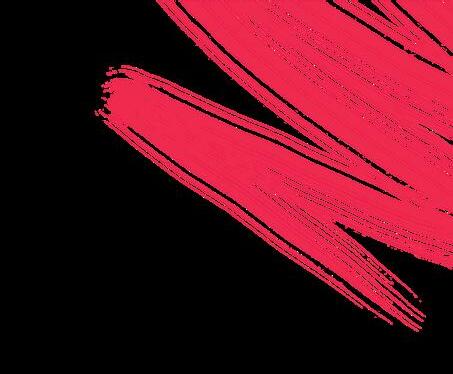
“In previous versions, I was a little frustrated by the size of Rocksteady’s head, him being a rhinoceros. A rhino’s defining feature is his horn. So I imagined Rocksteady with a humongous, imposing head just to bring out what really gives a rhino his strength: the incredible charging power of a rhinoceros horn.”


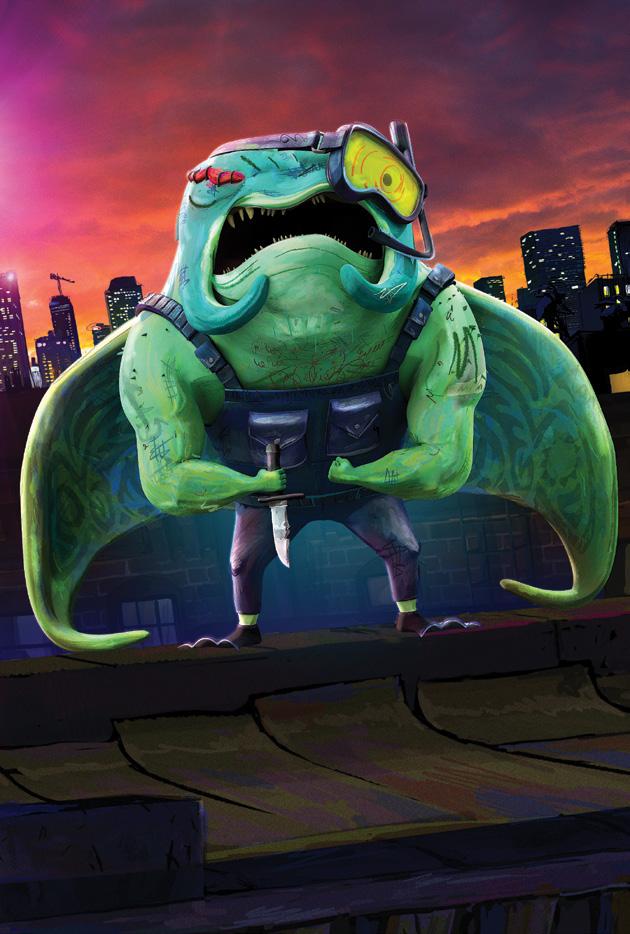
“I decided that Mondo is a raver because I love rave culture and I love the fashion, and I thought it applied well to Mondo’s very chill, sort of “go with the flow” attitude. The original Mondo Gecko is a product of ’80s radical skateboarder energy, and this is Mondo Gecko a decade or two decades onwards into the ’90s and 2000s sort of fashion.”
“I wanted to give him a more menacing edge. And I wanted to also inject more actual manta ray into his character. Ray Fillet is like an action movie scuba diver commando character—like a Jean-Claude Van Damme or Arnold Schwarzenegger type. So I gave him these tactical scuba suspenders and gave him a knife and made him really hardened and rugged.”
“I definitely leaned into the very animal aspect of Wingnut. Earlier versions of Wingnut had two arms, two wings, or two legs, and I wanted to keep Wingnut more bat-like by keeping her two arms on her wings and giving her cybernetic arms because [she’s a] cybernetic mutant. [Original Wingnut] has mechanical wings. The more I fussed with the mechanical wings, I became a little too frustrated…. So I placed the cybernetic part of Wingnut on her arms to sort of retain that futuristic, high-tech element.”

 BY MIKE CECCHINI
BY MIKE CECCHINI
Approximately 40 years after Teenage Mutant Ninja Turtles co-creators Kevin Eastman and Peter Laird first jokingly sketched a masked turtle standing upright with a pair of nunchaku strapped to its little arms, TMNT is one of the biggest franchises in the world. Leonardo, Donatello, Raphael, and Michelangelo are now veterans of not only years of comic book storytelling, multiple beloved animated series, blockbuster films, video games, countless toys, and more, but their Renaissance-inspired names are now household ones, and their adventures have delighted multiple generations of children and adults. In short, the TMNT are a genuine pop culture institution, a status that’s only going to be further cemented with the release of Teenage Mutant Ninja Turtles: Mutant Mayhem, a breathtakingly animated new feature film with an all-star voice cast and an authentically “teenage” attitude and sense of humor.
So, naturally, TMNT co-creator Kevin Eastman would have something to say about it. You might think that after nearly four decades, Eastman would be tired of talking about his most famous creations. But when we catch up with him via Zoom, literally half the world away, as he visits Perth, Western Australia, to make an appearance at a convention, you’d never know it. Wearing a baseball cap adorned with that original Ninja Turtle sketch, Eastman still lights
The co-creator of TMNT takes us back to their humble beginnings, gives us a little franchise history lesson, and explains how it all ties in to

up when he recounts the tale of how he and Laird first dreamed up the world’s most beloved reptiles. He’s still grateful for the fact that the pair were able to keep their creative control as their humble independent comic became a multimedia empire, a move that certainly isn’t the norm when talking about superhero success stories throughout history. But most of all, he still gets excited when talking about these characters and the expansive world they now inhabit.
No, Eastman clearly still has plenty to be excited about with TMNT. A big part of that is the impending release of Mutant Mayhem, which he has no shortage of praise for, and he gets visibly animated himself when we turn our conversation toward it. It may have been the end of a long convention day for the creator when we speak, but he has plenty of time and energy to share with fans about where the Turtles have been and where they’re going next.
Honestly, the idea of the Turtles came from such a place of passion and purity for [TMNT co-creator] Peter Laird and me. Growing up as huge fans of comics, we bonded immediately over our mutual heroes, like Jack Kirby and many others, who led us down this path of inspiration to tell our own stories. We wanted to put everything we loved about comics into an idea.

So late one night, Peter and I were working on a couple of ideas. I had this idea of a martial artist like Bruce Lee or
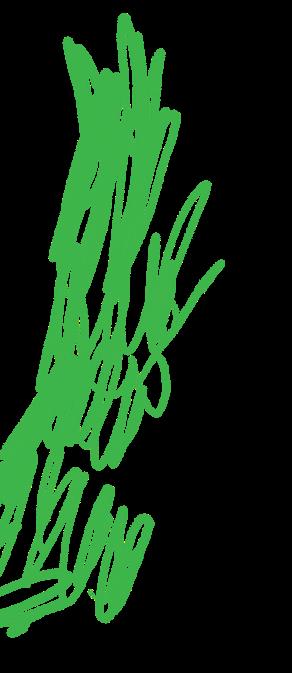
Jackie Chan as an animal, and what would be the stupidest animal it could be? I thought of a turtle. So I did the first sketch of a turtle standing upright with a mask on and nunchaku strapped to his arms, put it on Peter’s desk, and said, “This is a Ninja Turtle. It’s going to be the next big thing” with a big laugh. So Peter did a sketch and changed some things, and we immediately said, “Well, why not a group of them?”
I did a pencil sketch: four turtles, all with different weapons in this sort of comic book cover pose, and when Peter inked it, he added the “Teenage Mutant” to the “Ninja Turtles” title that I had put on the drawing. It was laughout-loud-funny. We said, “This is the dumbest thing we’ve ever seen. This is the coolest thing we’ve ever seen. We love it. Let’s come up with a story that tells how these characters became the Teenage Mutant Ninja Turtles.”
We spent the next several months creating a 40-page comic that told the origin story. We took all our favorite bits
from all the things we loved about all things comics and put them into this one book. We only did one book with a beginning, middle, and end because we never thought there’d be anything more than the first issue [at the time]. But we had big grins on our faces because we’d done it. We’d created our own characters and put out our first comic books with the help of some family crowdfunding to help cover the cost of the first 3000 copies…We were bound and determined we were going to be comic book storytellers.

What has given them such timeless appeal? And what makes new interpretations like Mutant Mayhem so vitally important?
Take, for example, something like Marvel’s Fantastic Four, where you have this family, both a specific family and adoptive family, a group of people that have different strengths, different powers, who could bicker and argue and have differences of opinion, but when they are bound together as one, focused as a family, they would always
succeed. That was very adaptive to a school group that you’d hang out with or friends in the workplace, those kinds of things. So I think that there were a lot of familial elements. And then you combine that with characters being the heroes we always hope we’ll be when the chips are down and people, especially family and the ones we love, are counting on us to do the right thing.
And then there’s the fact that the Turtles aren’t of any specific race, creed, or color, so to speak. I love that I can be anywhere and talk to anyone of any nationality or race and ask, “Who’s your favorite Turtle and why?”... It’s the underdog factor, the hero that we all would like to be, that Peter Parker/Spider-Man aspect of “I just want to be a teenager.” It’s all those things.
We just put things that we liked into it. What we liked about ourselves… things that we wanted to see in the characters. I think that made them special to us. We weren’t writing for anybody else. We never thought anybody else would actually buy the book [laughs]. So it’s amazing to think that we’re having this conversation nearly 40 years after that first issue, and it’s still resonating in some capacity with the original fans and the newer fans that have come on board throughout the years. It’s become this fantastically humbling generational concept. It’s wonderful. I think that’s probably what I like about going to conventions, getting to meet these people.
But looking at a project like Mutant Mayhem, the people that brought this story to life grew up as fans [so] the things that they’re putting into it are things that they loved about it, or they wanted to see in it, and that got their imagination going. So when they put that same passion into the idea, it works because it’s meaningful and it feels so good.
When did you realize that you had something special on your hands?
It really did come in a series of milestones for us. The first issue of the comic came out in May of 1984. The first five episodes of the animated series ran around Christmas break in 1987. The first toys shipped in June of 1988. For us, the first milestone and probably the most important was in 1985, when we were getting orders in from distributors for issue two, and it was 15,000 copies, [12,000 more than issue one]. Peter quickly did some math, and we figured that if we could do six of these comics a year, we could pay our rent, eat, and draw comics for a living full-time. And it just continued to grow from there.
Then suddenly, we were presented with opportunities to develop a cartoon show and a toy line. We loved the idea, but we felt very protective of it because it was an idea that we owned, and being huge fans and respectful to the heroes that we followed who didn’t have the rights to control their
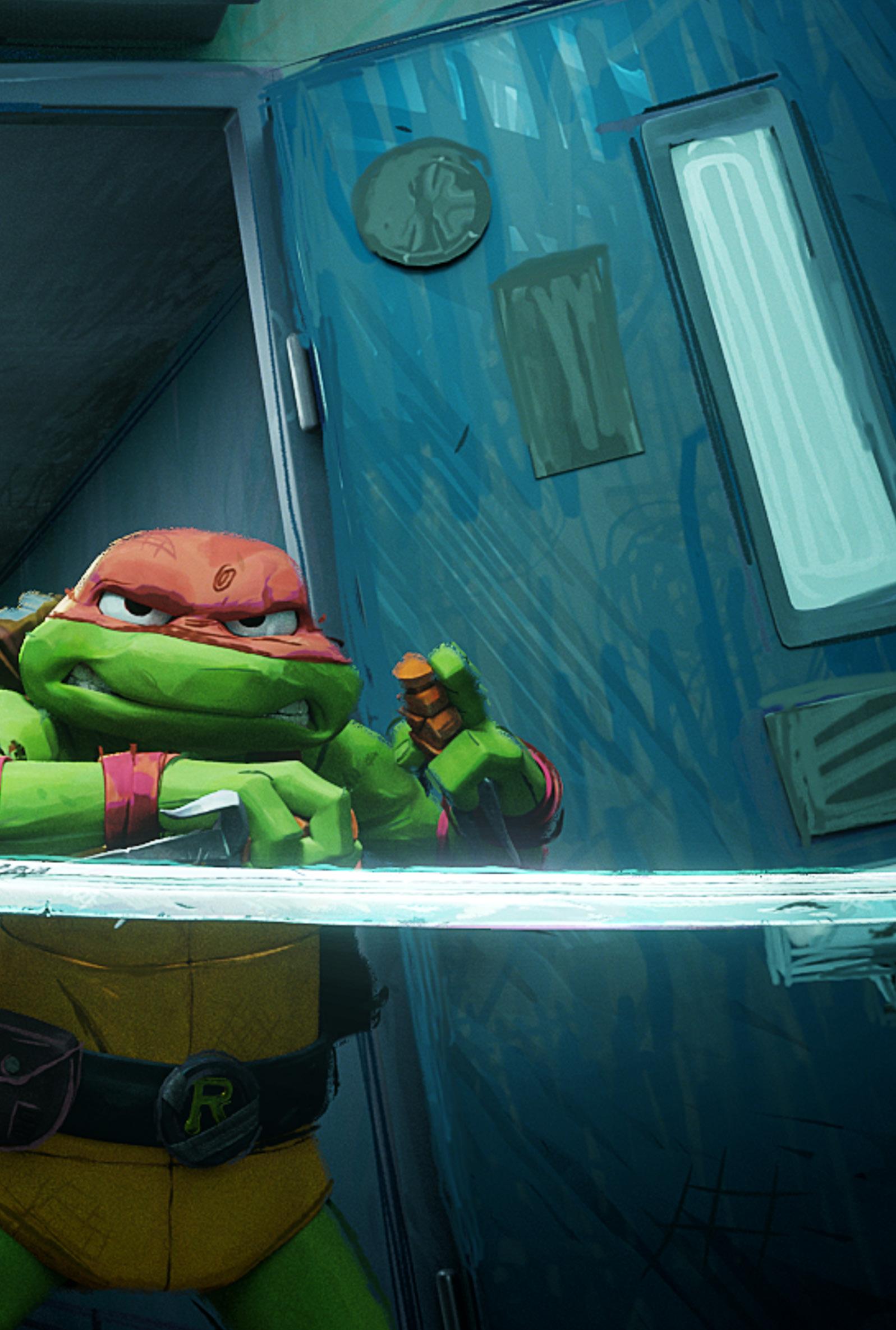
“I think fans are really going to love his version of Splinter. It’s quite endearing and polite. It’s heartwarming.”
L-R:Michelangelo, Donatello, Leonardo, and Raphael strike a heroic pose in Mutant Mayhem
properties, we were very careful. So we said, “We’ll do this, but on our terms, we’ll have full approval; nobody can do anything with the characters without it,” and we kept it really restricted and limited. So when [the animated series and toys were first released], we hoped for the best. But it really clicked with fans, and before we knew what we were doing, we had jumped on board this very fast-moving train, but in control of the train, at our pace, so to speak, and thrilled that we get to have the participation we wanted to with the characters.
But I sort of sum it up by… my grandmother used to send me $5 in a birthday card or Christmas card most of my life. She was watching TV one night, and the TMNT were a question on Jeopardy. And she finally felt at that point that I was successful enough and that the Turtles were popular enough that she didn’t need to send me $5 in my birthday card or at Christmas. She was very proud.
What is the one fundamental quality that is most important for each of the Turtles?
As the Turtles were designed, however naively and happily, almost accidentally, if you will, we modeled personalities in the early days based on either pop culture characters or comic characters or genres. Donatello was based on Peter Laird, he was the geekiest guy I knew, and I always thought about him when we wrote him. Raphael was the tough guy in school. I feel like it was that core [concept of] four turtles as lost orphans adopted by this incredible father figure, Splinter, even as we expanded the family to bring April O’Neil and Casey Jones in… this wonderfully adoptive family seemed to be the heart and soul.
How is Mutant Mayhem the logical evolution of that for 2023 and this generation’s TMNT fans?

It seems like every generation of the TMNT can build upon those personalities [but] it’s still built around that heart and soul family aspect. What immediately struck me about Mutant Mayhem was that the family aspect is really the core. It’s the love and appreciation. You know what they say, “You don’t always like your family, but you always love your family.” That seems very prevalent. One of the things that struck me the most about Mutant Mayhem is the dialogue and the ebb and flow of how the family talks. They overtake each other, and they’re talking at the same time, and it’s going back and forth. You can be all over the place, but you’re still on the same page, and the love is there. I think that’s the core that’s held them together throughout their entire history.
Did you know when you introduced April O’Neil in issue two that this character was going to be the human anchor of all their stories going forward? No, and what I mean by that is, when we did issue one, we never imagined there would be an issue two. When we did issue two, we hoped it would be received well enough that we’d be able to do an issue three and more. So when we brought in April, we immediately fell in love with her as a character. We were big fans of characters like Sarah
Connor [from the Terminator films] or Ellen Ripley [from the Alien movies]. So by the time we finished issue #2, we knew we wanted to keep her in the family; we felt she was a perfect, strong, kind of sisterly character that brought another perspective. She was more of a specific connector to the above-ground world, the “real world” for the Turtles, who had been underground the whole time. So it gave us a wonderful character and a plot point that we could develop further into telling bigger stories.
It’s almost like when you meet somebody new, and you already know you’re gonna be good friends. You know, even though you’ve not really known them that long, they’re going to be part of your life forever. And I feel like that’s the feeling [we had with April]. That’s the approach that we took to bringing April into the family.
I think about so many different and wonderful creators that I’ve had the chance to work with over the years. But the importance of updating the character into a person of the here and now who makes the kinds of comments and does the kinds of things she does, it just feels fresh, alive, and modern, and it works so well.

Peter and I, in the early days, were big fans of characters like Yoda and Mister Miyagi. It was about having a Sensei, having a parental figure that was very tough on you, but it wasn’t without love. I feel like we had that with Splinter in
“Everyone gets their moment, and it’s pretty awesome. It’s called ‘Mutant Mayhem’ for a reason.”
the early days of the TMNT when he was very protective. He was the father figure.
What about his portrayal in Mutant Mayhem?
I love how in Mutant Mayhem, they took it to even more of a protective level. Because we never completely touched on a lot of pre-Teenage Mutant Ninja Turtles history, I feel like some of the approaches they’ve taken here, it’s very reminiscent of the ways that I grew up, and I can definitely see the inspiration of, you know, “be careful, it’s a cruel world out there, be safe.” And I think it’s a very interesting character take for Jackie Chan as well. I think fans are really going to love his version of Splinter. It’s quite endearing and polite. It’s heartwarming.
We’ve never seen this many mutants in a TMNT movie before…
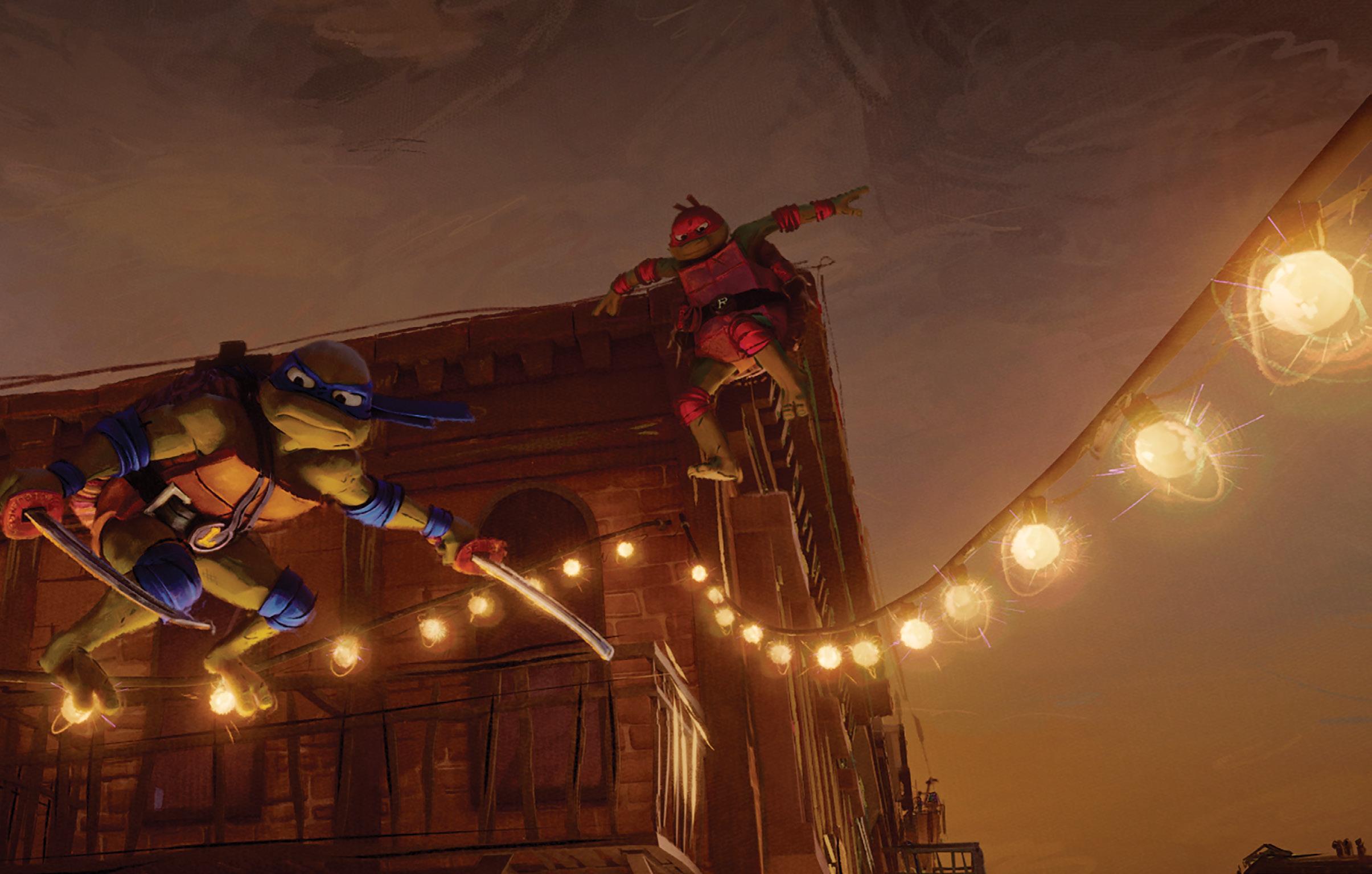
One of the things that has been so much fun is watching how the stories evolve and come together. One of the first licensing things that we did back in the day after the original comics was a role-playing game with Palladium Books back in 1985, which [featured templates for] all these different mutant characters that you play against or as. When we started developing the first cartoon show, we already had a wealth of material in this mutant universe that we could play with and build upon. Just about every version of the TMNT since the first cartoon has built on the ooze and the mutants. I like the fact that this movie doesn’t feature just one bad guy. Everyone gets their moment, and it’s pretty awesome. It’s called “Mutant Mayhem” for a reason.
What do you think about this voice cast?
I just love that they chose to do things like having real teenagers [voice the Turtles] and record them all together, interacting and responding to stuff, and allowing some of the improv and the organic nature of some of the conversations to ebb and flow the way that they did. It didn’t seem like, “Hey, let’s get this name because it would look good on a marquee;” it’s, “Get this person into this movie because they’ll do an incredible job as this character.” Nothing felt like an afterthought; it was all done with great purpose. And it comes across. Seth Rogen’s voicing Bebop! Paul Rudd doing Mondo Gecko! Ice Cube as Superfly! I’m looking at this stuff going, “Oh my god, this is so awesome. It’s really funny. This is really good stuff.” I was watching some of the scenes with my jaw hanging open. It’s perfect. It’s great.
How would you describe the animation style?
It’s a beautifully, wonderfully organic approach to the characters’ shape and how they move in depth in so many of the scenes. But what struck me, in particular, was how everything had weight and balance, and it felt grounded. You can stylize [animation] in a way that can be distracting or pull away from the story that you’re trying to tell, but everything that they’ve done with the style furthers the story. What [director and co-writer] Jeff did so well is really put the focus on the story and the moments and the beats. It has substance. It just felt good. It isn’t distracting. It keeps you engaged, and you forget everything else. All you care about is where the director is taking us. It’s fantastic.
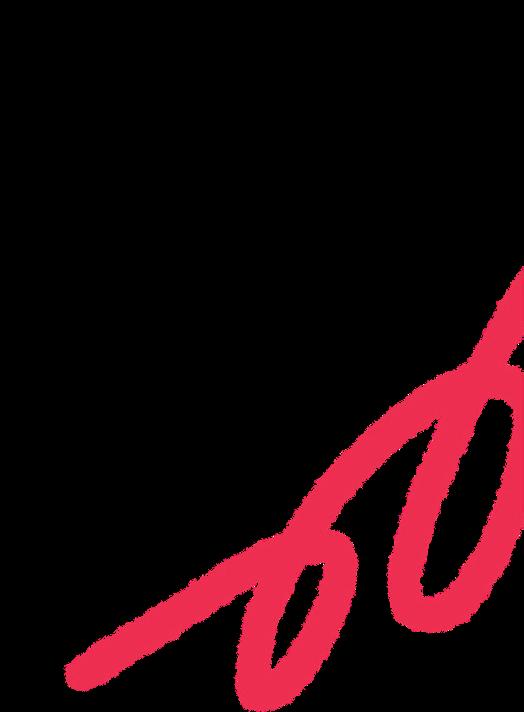
1980
May 1984
1983
Kevin Eastman and Peter Laird first come up with the idea of the TMNT.
Teenage Mutant Ninja Turtles #1 debuts with a print run of only 3,275 copies. Demand fuels additional printings and an ongoing series that will run for nearly a decade and spawn countless other comics.
December 14, 1987
The first animated series debuts. It will run for 10 seasons and 193 episodes.
Summer 1988
The first wave of TMNT action figures arrives, becoming one of the most successful toy lines in history.
Oct. 11, 1989
The TMNT arcade game is released. While not the first video game to feature the Turtles, to this day it remains the most beloved!
March 30, 1990
Feb. 8, 2003
A new animated series reboots the Turtles for TV. It runs for six seasons and spawns another successful wave of action figures and toys.
March 23, 2007
TMNT, an animated movie featuring the voices of Chris Evans, Sarah Michelle Gellar, Patrick Stewart, and others opens.
Sept. 28, 2012
Nickelodeon debuts a new Teenage Mutant Ninja Turtles animated series to critical and fan acclaim. It runs for five seasons.
Aug. 8, 2014
A new live action TMNT movie, produced by Michael Bay, arrives. A sequel follows in 2016.
July 20, 2018
Rise of the Teenage Mutant Ninja Turtles, a stylish take on the TMNT’s early days, premieres on Nickelodeon.
2020
The first live-action Teenage Mutant Ninja Turtles movie hits theaters. Sequels follow in 1991 and 1993.
Nov. 2, 1996
The final episode of the original animated series airs. But you can’t keep a good Turtle down for long!
Nov. 21, 2009
Animated TV movie Turtles Forever airs. Years ahead of the multiverse trend, this story unites the 2003 animated Turtles with their 1987 TV versions and the Eastman and Laird comics versions.
August 2011
IDW Publishing kicks off a new Teenage Mutant Ninja Turtles comic series that is a brilliant entry point for new fans of the comics. It’s still going strong today.
Aug. 2, 2023
CAPTURING 40 YEARS OF TURTLE POWER IN ONE PAGE IS IMPOSSIBLE, BUT HERE ARE SOME HIGHLIGHTS!
